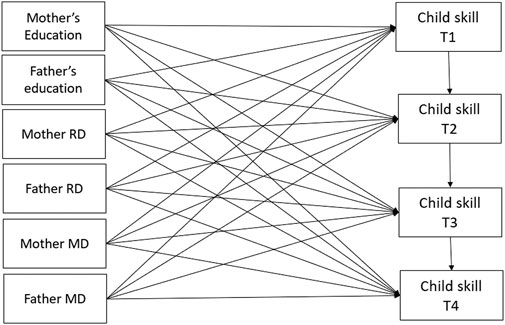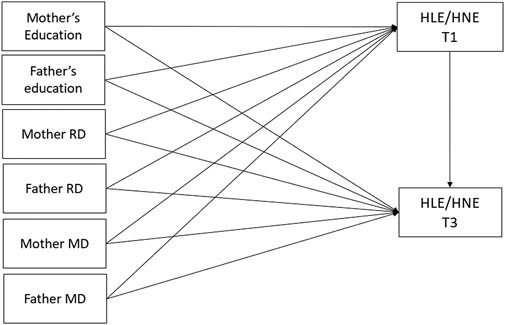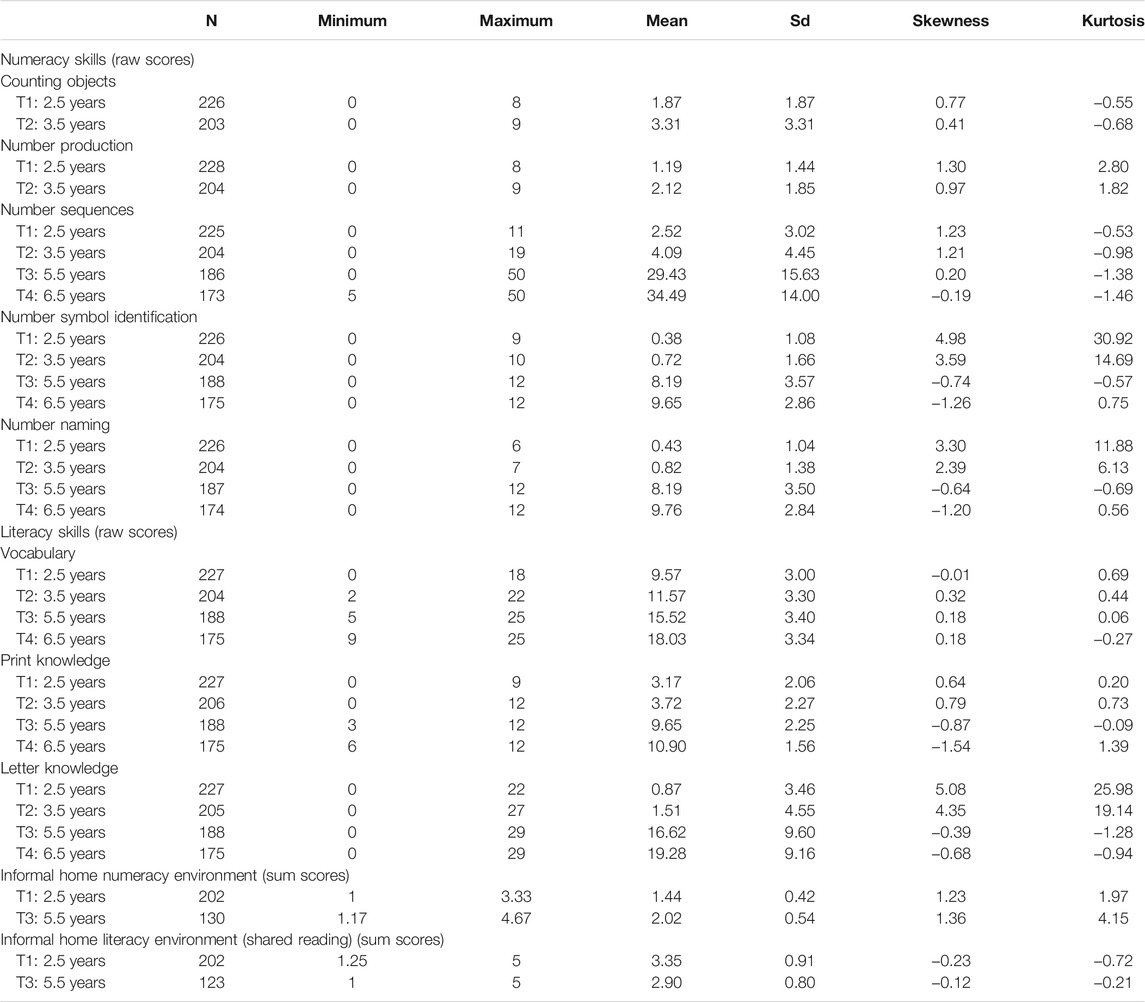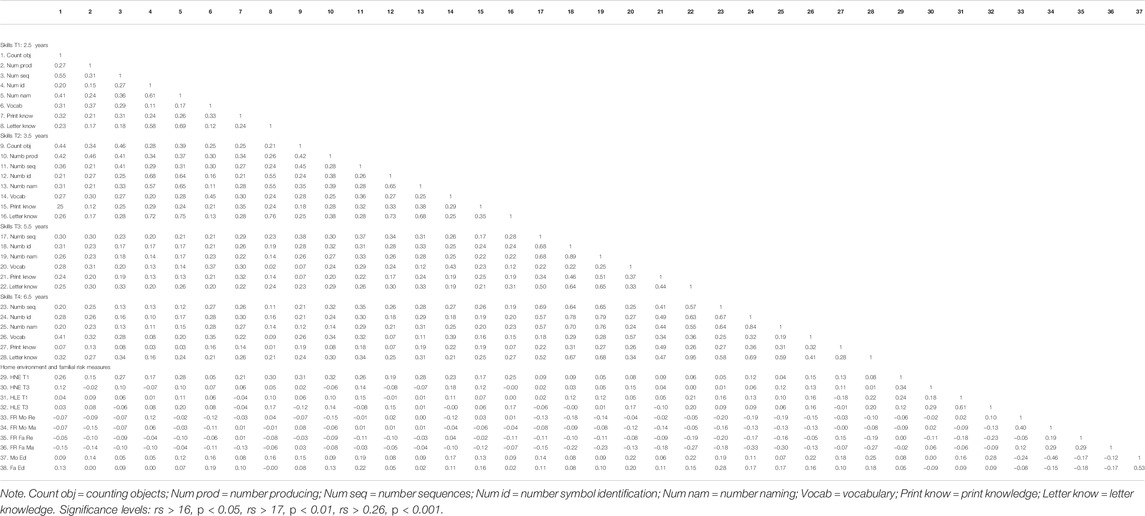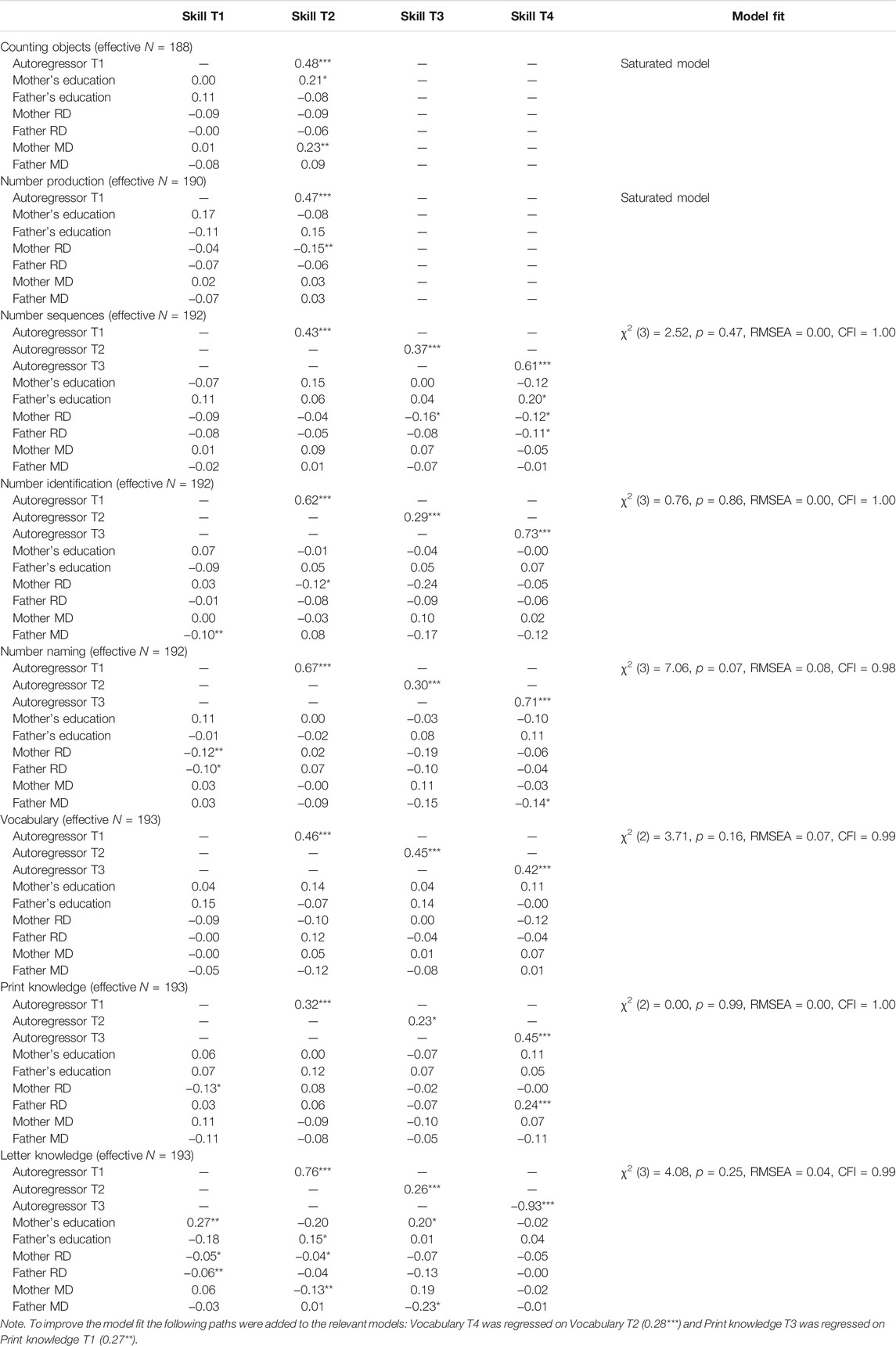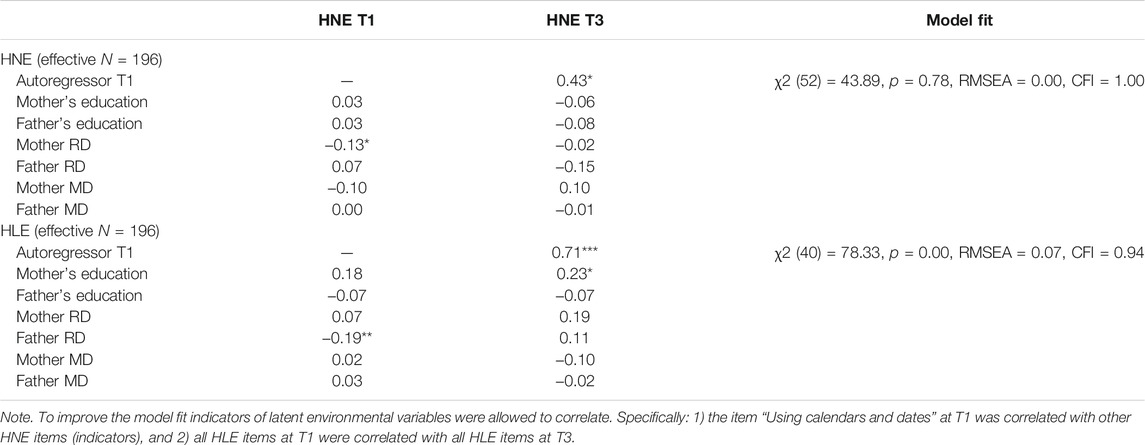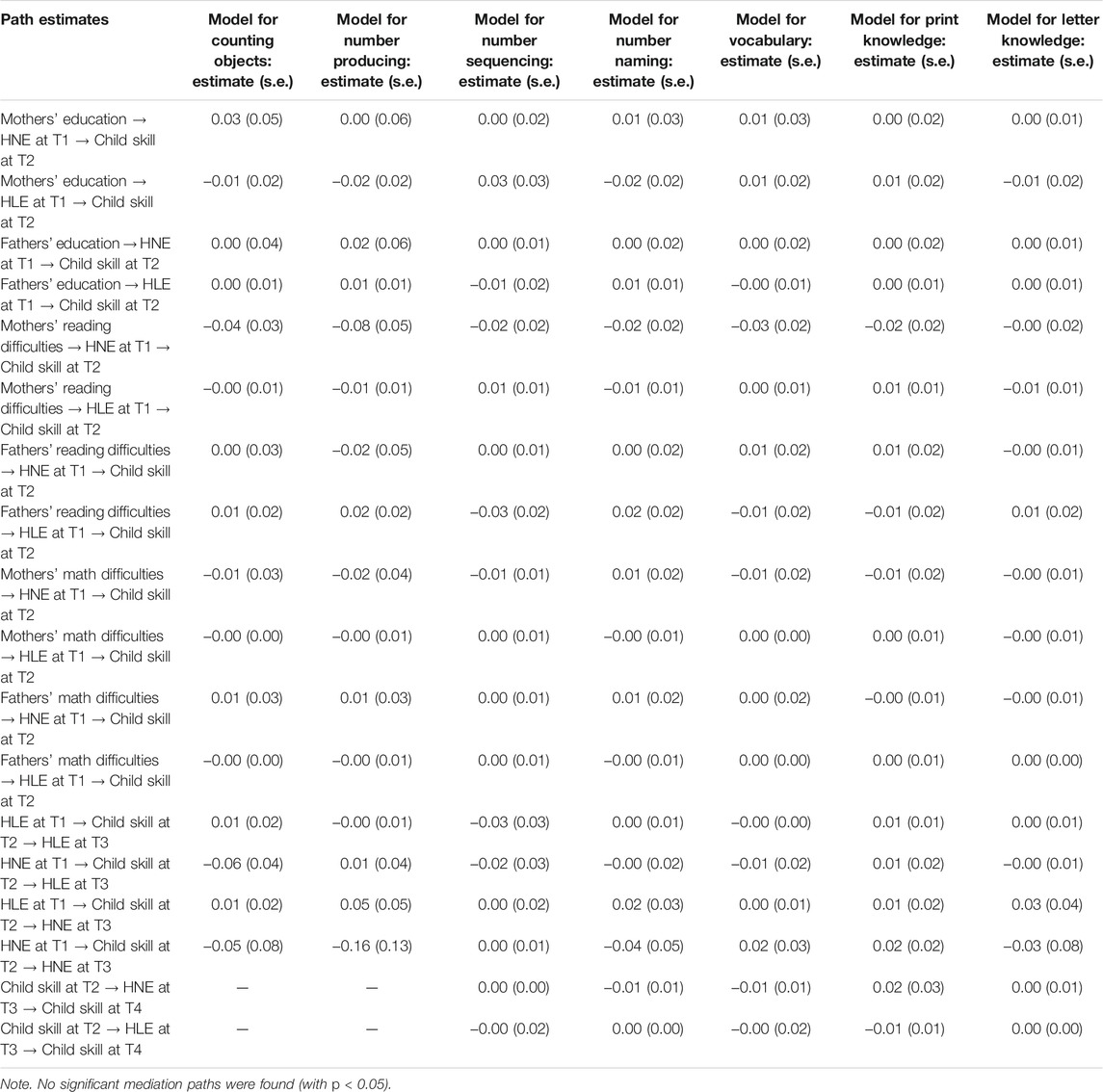- 1Department of Teacher Education, University of Jyväskylä, Jyväskylä, Finland
- 2Department of Education, University of Jyväskylä, Jyväskylä, Finland
This study examines the direct and indirect effects of home numeracy and literacy environment, and parental factors (parental reading and math difficulties, and parental education) on the development of several early numeracy and literacy skills. The 265 participating Finnish children were assessed four times between ages 2.5 and 6.5. Children’s skills in counting objects, number production, number sequence knowledge, number symbol knowledge, number naming, vocabulary, print knowledge, and letter knowledge were assessed individually. Parents (N = 202) reported on their education level, learning difficulties in math and reading (familial risk, FR), and home learning environment separately for numeracy (HNE) and literacy (HLE) while their children were 2.5 years old and again while they were 5.5 years old. The results revealed both within-domain and cross-domain associations. Parents’ mathematical difficulties (MD) and reading difficulties (RD) and home numeracy environment predicted children’s numeracy and literacy skill development within and across domains. An evocative effect was found as well; children’s skills in counting, number sequence knowledge, number symbol identification, and letter knowledge negatively predicted later home numeracy and literacy activities. There were no significant indirect effects from parents’ RD, MD, or educational level on children’s skills via HLE or HNE. Our study highlights that parental RD and MD, parental education, and the home learning environment form a complex pattern of associations with children’s numeracy and literacy skills starting already in toddlerhood.
Introduction
Early childhood and toddlerhood is the developmental stage when children develop at their fastest rate and are most influenced by their environments (Gerber et al., 2010). This is also when the early literacy and numeracy skills create a foundation for future reading and mathematical skill development: Symbolic and nonsymbolic numeracy skills, assessed before school entry, have been shown to predict later mathematical skills (Watts et al., 2014; Zhang et al., 2014; Koponen et al., 2016; Koponen et al., 2019; Schneider et al., 2017; Chu et al., 2018; Geary et al., 2018), and early language and literacy skills have been shown to predict reading skills (e.g., Torppa et al., 2010; Ziegler et al., 2010; Psyridou et al., 2018; Hjetland et al., 2020). Reading and mathematical development are deeply interconnected processes, and emerging evidence reveals both shared and unshared predictors of reading and mathematical skill development (e.g., Purpura et al., 2011; Davidse et al., 2014; Purpura and Ganley, 2014; Purpura et al., 2017a; Korpipää, 2020; Vanbinst et al., 2020). At school age, the comorbidity of reading difficulties (RD) and mathematical difficulties (MD) is also common: The rate of the cooccurrence of these difficulties has been estimated to be approximately 30–70% (Landerl and Moll, 2010; Moll et al., 2019). Although the estimates vary considerably, existing evidence suggests that the likelihood of this comorbidity is significantly higher than chance. However, as we still have many unanswered questions about the very early development of reading and mathematical skills, and their co-occurrence, more research is needed.
This longitudinal study sets out to examine the development of emerging literacy and numeracy skills during early childhood to better understand the foundation for reading and mathematical skills. We examine the cross-domain associations of literacy and numeracy skills by focusing on the early development of several important literacy and numeracy skills and the family factors predicting them. We aim to add to the existing knowledge on the underpinnings of literacy and numeracy development by examining the roles of home numeracy (HNE) and literacy environment (HLE), familiar risk (FR, due to parental RD and/or MD), and parents’ education in children’s literacy and numeracy development from age 2.5 to 6.5. To better understand the developmental relationship between literacy and numeracy abilities and the common and unique factors associated with each domain, we will identify the within-domain and cross-domain predictive associations between children’s skill development, home environment, and parental RD and MD. Considering that early experiences create a significant starting point for young children’s skill development, longitudinal research beginning with toddlers is particularly warranted, and existing gaps in the literature show the need to gain new insights into early predictors of literacy and numeracy skills (e.g., Napoli and Purpura, 2018, p. 597; Esmaeeli et al., 2019, p. 2395). So far, only a few studies have examined the effects of the HNE and HLE on children’s literacy and numeracy skills with the effects of FR for MD and RD from a longitudinal developmental perspective, and they have been completed among older children and adolescents (e.g., Khanolainen et al., 2020).
Home Learning Environment and its Relation to Literacy and Numeracy Skills
The home learning environment (i.e., shared parent-child activities at home) plays an important role in developing literacy and numeracy skills (e.g., Scarborough and Dobrich, 1994; Sénéchal and LeFevre, 2002; Mol and Bus, 2011; Silver et al., 2020). The home learning environment is often conceptualized as including two domains: the home literacy environment (HLE) and home numeracy environment (HNE) (e.g., Napoli and Purpura, 2018), which have mainly been examined separately as predictors of domain-specific skills (literacy skills/reading or numeracy skills/math).
Previous research has revealed within-domain associations showing that the HLE is related to literacy outcomes (Scarborough and Dobrich, 1994; Sénéchal and LeFevre, 2002; Evans and Shaw, 2008; Mol and Bus, 2011), and the HNE is related to numeracy outcomes (e.g., Kleemans et al., 2012; Susperreguy et al., 2020; Daucourt et al., 2021). Since the number of studies on HNE and numeracy development has only sparked off over the past 10 years (Daucourt et al., 2021 for meta-analysis), research focusing on the role of HNE in children’s skill development remains less clear and conclusive compared with studies on HLE. Some HNE studies have not found a significant association between HNE and children’s outcomes (e.g., Missall et al., 2015), while some other studies have yielded mixed findings with positive associations between HNE and skill development for certain items, but negative associations for other items (e.g., Blevins-Knaube and Musun-Miller, 1996; Skwarchuk, 2009; DeFlorio and Beliakoff, 2015). Longitudinal studies starting in toddlerhood (Baker, 2014) and later in preschool at age 3–5 (Melhuish et al., 2008) have reported HLE predicting both reading and mathematical skills later in school, and likewise, HNE predicting numeracy and definitional vocabulary outcomes (Napoli and Purpura, 2018), suggesting that HNE and HLE also relate to children’s cross-domain outcomes. However, there is currently a lack of studies examining both HLE and HNE and their within- and cross-domain associations using the same dataset (as exceptions, Khanolainen et al., 2020; Manolitsis et al., 2013; Napoli and Purpura, 2018), and thus it is impossible to say whether the found cross-domain associations are unique or whether they reflect a more general quality of home environment and vanish when within-domain activities are included. Activities at home can also be a proxy of family resources and parents’ educational level. In line with this suggestion, parental education is linked not only directly to a child’s literacy and numeracy skills (e.g., Purpura and Reid, 2016; Esmaeeli et al., 2018; Silinskas et al., 2020), but also to the home environment, such as to the frequency of shared numeracy or literacy activities (e.g., Thompson et al., 2017; Khanolainen et al., 2020; Silinskas et al., 2020). For instance, Thompson et al.’s (2017) study, comparing the relation between specific HNE practices and children’s numeracy skills across preschool-aged children (3 and 4 years old), indicated that children from families with higher parental education may engage in more mathematical activities than children from families with lower parental education, particularly at younger ages. More studies are needed to clarify the within- and cross-domain associations between the home environment and children’s mathematical and reading development. Of particular importance are longitudinal studies that start early on, including both HLE and HNE, parental education, and literacy and numeracy skills.
In the studies on HLE and HNE, activities in the home environment have been further differentiated into separate categories (e.g., Scarborough and Dobrich, 1994; Sénéchal and LeFevre, 2002; Mol and Bus, 2011; Silver et al., 2020). Sénéchal and LeFevre (2002), as part of their Home Literacy Model, have introduced two categories of activities for HLE: formal and informal. Following their work, a similar model within the context of HNE was developed and evaluated by Skwarchuk et al. (2014). Formal activities are code-related activities that aim to instruct children. Informal activities are various playful activities involving print or numbers (e.g., shared reading or measuring ingredients while cooking). Evidence is accumulating to show that formal and informal activities contribute to developing skills for both literacy and numeracy (Sénéchal and LeFevre, 2014; Soto-Calvo et al., 2020) and that different practices in the home environment may relate to children’s skills at various ages (Thompson et al., 2017).
Previous studies suggest that informal HLE (e.g., shared reading) and HNE practices (e.g., children’s exposure to numeracy-related and play-based experiences and contents such as playing games; counting and quantity comparison) are more meaningful in supporting skill development in early childhood (e.g., Sénéchal, 2006; LeFevre et al., 2009; Hamilton et al., 2016; Thompson et al., 2017), possibly through their associations with nonsymbolic numeracy skills (Skwarchuk et al., 2014). Longitudinal studies in kindergarten through the first years of primary school have shown that for HLEs, informal literacy activities are associated with developing vocabulary knowledge and reading comprehension (e.g., Sénéchal, 2006; Torppa et al., 2007; Sénéchal et al., 2008; Sénéchal and LeFevre, 2014). Simultaneously for HNE, in two cross-sectional studies with 5 to 6 year olds, informal home numeracy practices (i.e., children’s exposure to numeracy-related content such as playing games) were shown to predict children’s nonsymbolic arithmetic performance (e.g., Skwarchuk et al., 2014; Mutaf Yildiz et al., 2020).
Only a handful of studies have included measures of informal HNE and HLE as predictors of literacy and numeracy skill development (e.g., Manolitsis et al., 2013; Susperreguy et al., 2020), and none have begun the investigation with toddlers. In the present study, we investigate the associations of informal HNE and HLE with children’s literacy and numeracy development in a longitudinal sample in early childhood (ages 2.5 through 6.5) to examine whether the within-domain and cross-domain effects appear before children begin school in the Finnish system.
Familial Risk for Reading and Mathematical Difficulties and Relations to Literacy and Numeracy Skills
Both RD and MD run in families (e.g., Snowling and Melby-Lervåg, 2016). This means that the children born in families where parents have difficulties in reading or mathematical skills are at higher risk to develop such difficulties themselves. The group of children with parental RD or MD are therefore often referred to as familial risk (FR) group. RD is up to 4–10 times more likely to occur in children with FR than in children without it (Puolakanaho et al., 2007; van Bergen et al., 2014; Hulme et al., 2015; Torppa et al., 2015; Esmaeeli et al., 2019). Parental MD seems to influence children’s development in a similar manner, although relevant research remains scarce (Shalev and Gross-Tsur, 2001; Soares et al., 2018). It is possible that genetic FR has a direct influence on children’s skills, but parental skills in reading and math may also interact with the home learning environment (Hamilton et al., 2016; Dilnot et al., 2017; Esmaeeli et al., 2018). Without sufficient parental skills, the home learning environment may not be as supportive (e.g., fewer activities where children can learn literacy or numeracy skills) in the FR families. Parental RD and MD have been shown to be transmitted through environmental factors in some studies (Petrill et al., 2005; Niklas and Scheinder, 2014; de Zeeuw et al., 2015; Hart et al., 2016; van Bergen et al., 2017), while some other studies have not found differences between the home environments of FR and non-FR families (e.g., Elbro et al., 1998; Torppa et al., 2007; Caglar-Ryeng et al., 2020). Although studies on the interaction of FR and the HLE are emerging (e.g., Esmaeeli et al., 2019), comparable research investigating the influence of FR on the HNE is almost nonexistent, and the few existing studies (Silinskas et al., 2010; Niklas and Scheinder, 2014; Khanolainen et al., 2020) were conducted with kindergarten and primary school-aged children and showed somewhat mixed results. In the study by Khanolainen et al. (2020), neither MD nor RD predicted the frequency of shared reading or parental teaching activities at home when parental education was controlled for. At the same time, Niklas and Schneider’s (2014) study showed that certain informal HNE activities (e.g., playing dice, counting, and calculation games) occurred less frequently in families with MD compared with families without MD. Additionally, Silinskas et al.’s (2010) study showed that mothers’ but not fathers’ MD predicted their formal teaching of math in the first grade, suggesting also the need to incorporate measures of FR for both parents into studies investigating home environment effects on children’s skill development (van Bergen et al., 2017). Our study focuses on the early years because that is when the associations between FR, HLE, HNE, and children’s skills are likely to emerge (e.g., Hart et al., 2009; Hart et al., 2016).
Children’s Skills and Evocative Effects With Home Learning Environment
While it is widely acknowledged that both HLE and HNE contribute to children’s literacy and mathematical outcomes, children’s individual characteristics (i.e., their emerging literacy and mathematical skills) may also shape the home learning environment (Scarr and McCartney, 1983; Pomerantz and Eaton, 2001). The term “evocative effect” refers to adults’ responses arising from their children’s characteristics, such as skills or academic performance (Plomin et al., 1977; Scarr and McCartney, 1983; Rutter et al., 2006; Silinskas et al., 2013). Previous research among school-aged children has shown that the child’s poorer academic skills and achievements may evoke more parental academic involvement in both HLE and HNE (Levin et al., 1997; Pomerantz and Eaton, 2001; Silinskas et al., 2020). Additionally, children with higher pre-reading skills have been shown to attract more frequent at-home reading activities by parents (Silinskas et al., 2012).
As FR operates through genes, it is also plausible that FR impacts children’s skills and via children’s skills in the home environment (e.g., Plomin et al., 1977; Rutter et al., 2006; Knafo and Jaffee, 2013; van Bergen et al., 2014). The child’s skills are likely to impact how often the child participates in various learning activities (active effects on environment) and how often parents engage in shared learning activities with the child (evocative effects on environment). However, these effects of children’s emerging skills have been mainly examined at the age of kindergarten or school entry (e.g., Silinskas et al., 2010), leaving early childhood an understudied area.
The Present Study
This longitudinal study focuses on literacy and numeracy development during early childhood (from age 2.5–6.5). We aim to add to existing knowledge on the underpinnings of early literacy and numeracy development by examining the roles of HNE, HLE, and FR for RD and MD, and parents’ education in children’s literacy and numeracy development in early childhood. To better understand the developmental relationship between literacy and numeracy skills and the common and unique factors associated with each domain, we will identify the within-domain and cross-domain predictive associations between children’s skill development, home environment, and parental factors (education, RD, and MD).
The research questions being studied are: 1) To what extent do parental MD and RD and their education level predict a) their children’s numeracy and literacy development in early childhood, and b) HLE and HNE? 2) To what extent do HLE and HNE predict children’s numeracy and literacy development in early childhood? 3) To what extent do children’s early numeracy and literacy skills predict HLE and HNE? 4) Are there indirect effects from parental RD and MD and their educational level on children’s numeracy and literacy development through the home environment?
Methods
Participants and Procedure
The data were collected as part of the VUOKKO follow-up study (Lerkkanen and Salminen, 2015–2019). A sample of children born in 2013 (N = 265; 138 male, 127 female), with their parents and early childhood education and care (ECEC) educators were recruited from one middle-sized city in Central Finland. Children’s emerging math and literacy skills were assessed four times during the follow-up: Twice at toddler age T1 (MAge 28.73 months, N = 228) and T2 (MAge 34.69 months, N = 206), and twice further in later childhood T3 (MAge 64.71 months, N = 188); and T4 (MAge 70.83 months, N = 175). Parents reported on their education level and learning difficulties in mathematics and reading (familial risk, FR) and replied twice: T1 (N = 202) and T3 (N = 130). They also responded to several questions on the home learning environment, including items for numeracy (HNE) and literacy (HLE).
Measures
Emerging Numeracy Skills
The following two tasks were administered at the first two time points: counting objects and number production. These three tasks were administered at all four time points: number sequence knowledge, number symbol knowledge, and number naming.
Counting Objects
The child’s counting skills (i.e., order of the number words, mastering the counting principles) were assessed with a simple counting task (modified from Hannula and Lehtinen, 2005). The task began with placing four wooden buttons on the table in front of the child, with a piece of paper blocking the visual field. The paper was removed, and the child was asked to count how many buttons there were. If the answer was correct, the child would be given 5, then 6, 8, 10, and 12 buttons to be counted. If the child counted four buttons incorrectly, the next trial was two, and if the child further failed on two, the next trial was one button. Each item included two trials. The highest number of correctly counted buttons was used as the score for the counting objects task (maximum nine points).
Number Producing
The “Give me X” task (Wynn, 1990; Wynn, 1992) was used to tap children’s number concept skill. In this task, the child was asked to pick up an amount of plastic figures from a box with a lid on (e.g., Give me four strawberries). Before removing the lid and giving the child a turn, the child was asked to confirm how many strawberries they were supposed to give. The test included eight items with increasing difficulty, and each item included two trials. If the child failed in both trials for the specific item, the task was terminated. The highest number of correctly produced items produced the score used in the analysis (maximum 19 points).
Number Sequences
The child’s skill in producing number sequences was measured with a verbal task (Hannula and Lehtinen, 2005). The child was asked “How long can you count?” and the child was allowed to enumerate as many numbers as possible, starting from one. If the child was reluctant or unable to start, the researcher modeled numbers from one to twelve and gave a turn to the child. The child had two trials, and the longer number sequence without mistakes was considered the score for number sequence skills in the analysis (maximum 50 points).
Number Symbol Identification
The child’s number symbol identification skill was assessed with a task (Wright et al., 2006) in which the child was shown an A4-sized paper with numbers 1–10 on it in a mixed order. The child was asked to point where the requested number was. The test proceeded in segments of three numbers; if the child knew at least two number symbols, another set of three numbers was introduced. If these were correct, the child was introduced with a paper with numbers from 11 to 20 on it. The third paper included numbers from 22 to 50. If the child did not recognize at least two numbers per sheet, the task was terminated. The number of correct responses determined the score used for the analysis (maximum 12 points).
Number Naming
Number naming skills were assessed with a task (Wright et al., 2006) in which a deck of twelve cards with numbers on them was spread on the table before the child. One number at a time was pointed at, and the child was asked to tell the researcher what the number was called. The task proceeded in segments of three numbers. If the child knew two out of three numbers, three more questions were introduced. If not, the task was terminated. The number of correct responses determined the score used for the analysis (maximum 12 points).
Emerging Literacy Skills
The following three measures on emerging literacy skills were administered at all four time points: vocabulary, print knowledge, and letter knowledge.
Vocabulary
The breadth of the child’s vocabulary was assessed with the Peabody Picture Vocabulary Test-R (PPVT-Short: Dunn and Dunn, 1981). In this task, the child was shown a set of 30 A4-sized papers with four pictures on each. For each sheet of paper, the child was told a word and asked to point out which picture included the target word. The test included two practice items and 30 test items. Different words were used for T1 and T2 from T3 and T4 to better fit the measure for different age groups. The number of correct responses was used as the score for the analysis (maximum 30 points).
Print Knowledge
The child’s print knowledge was assessed with the print awareness subtest of the Test of Preschool Early Literacy (TOPEL; Lonigan et al., 2007). The child was shown a set of 12 A4-sized papers with four pictures on each. Pictures could represent e.g., four different book covers, one with title written with words, one with a price tag (number symbols), and two with picture on the cover. The child’s task was to point a picture with letters on it. There were twelve items in the actual test, and the child went through them all in sequence, regardless of performance. Number of correct responses was used as the score for the print knowledge task (maximum 12 points, α = 0.56, 0.74, 0.71, and 0.66 for T1, T2, T3, and T4, respectively).
Letter Knowledge
Letter knowledge was assessed with two tasks: in T1 and T2 with the VIIVI test (Torppa et al., 2006; Lohvansuu et al., 2021) and in T3 and T4 with the ARMI test (Lerkkanen et al., 2006). In the VIIVI letter naming task, the child was asked to name letters written in capitals and presented one at a time on their own page. The child was presented with 29 letters organized in four sets (6 + 6+4 + 13 letters). The child received one point for each correct response (use of a phoneme or a letter name were both coded as correct responses). The testing always began by presenting the child with the letter expected to be most familiar to the child: the first letter of the child’s own first name (maximum 29 points). The ARMI test battery includes a naming test of all 29 letters in the Finnish alphabet. The letters were presented as uppercase letters in three rows and were shown to the child one row at a time. The total score corresponded to the number of correctly named items (maximum 29 points, α = 0.51, 0.72, 0.92, and 0.94 for T1, T2, T3, and T4, respectively).
Parent Reported Learning Difficulties in Reading and Mathematics
One parent per each participating child responded to the questionnaire. These parents were asked to fill in a questionnaire asking if they and/or the other parent of the child had experienced learning difficulties 1) in reading or writing, and 2) in mathematics or calculation. The questionnaire included one question about their own difficulties in reading or writing, one about their own difficulties in mathematics or calculation, and the same two items concerning the other parent. The parents answered each question on a 3-point Likert scale (1 = no difficulties, 2 = some difficulties, and 3 = clear difficulties). Variables for the analysis were created based on recoding the self-reports and those of the other parent into fathers’ and mothers’ RD and MD according to a variable indicating which parent had completed the questionnaire (mother or father). RD and MD variables were then dichotomized so that parents who indicated either some or clear difficulties were placed in the same group with difficulties. 20 (out of 208) mothers had reading difficulties and 32 (out of 207) had mathematical difficulties. 21 (out of 202) fathers had reading difficulties and 14 (out of 200) had mathematical difficulties.
Parent Reported Education
Parents were asked to indicate the level of their own vocational education and that of the other parent on a five-point scale {1 = no vocational education [3.4% (N = 7) of mothers and 9.4% (N = 19) of fathers], 2 = vocational school degree [30.4% (N = 63) of mothers and 37.9% (N = 77) of fathers], 3 = vocational college degree [3.4% (N = 7) of mothers and 6.4% (N = 13) of fathers], 4 = polytechnic degree [31.4% (N = 65) of mothers and 22.7% (N = 46) of fathers], 5 = university degree [31.4% (N = 65) of mothers and 23.6% (N = 48) of fathers]}. Variables for the analysis were created based on recoding the self-reports and those of the other parent into fathers’ and mothers’ vocational education, according to a variable indicating which parent had completed the questionnaire (mother or father).
Parent Reported Home Learning Environment
Home Literacy Environment
Informal HLE was documented with four shared reading items in accordance with the Home Literacy Model (Sénéchal and LeFevre, 2002). The parents were asked to report how often they participated in the following activities: “viewing illustrations in a book with the child,” “reading books to the child when they were going to bed,” “mother reading a book or magazine with the child,” “father reading a book or magazine with the child.” They responded to the items using a Likert scale (1 = Not at all or rarely; 5 = Several times a day). Cronbach’s alpha reliability coefficients indicated that the internal consistency of shared reading was .84 at T1 and .81 at T3.
Home Numeracy Environment
Parents were asked to complete the home numeracy questionnaire developed by LeFevre et al. (2009). There were seventeen items on the scale to which parents responded using a Likert scale (1 = Not at all or rarely; 5 = Several times a day). They were asked to respond to the following question: “In the past month, how often did you and your child engage in the following activities?” Not all the items functioned well across the time points of the study. Therefore, like LeFevre et al. (2009) and Mutaf Yıldız et al. (2018) we dealt with numeracy environment items by eliminating those that were rarely reported at each time point by the parents (all items to which at least 80% replied “never”). At T1, these seven items were excluded (in parentheses, the percentage of “never” responses): “Printing numbers” (87%), “Connect-the-dot activities” (100%), “Using number activity books” (88%), “Being timed” (80%), “Having your child wear a watch” (95%), “Talking about money when shopping” (84%), and “Playing with calculators” (88%). At T3, two items were discarded: "Having your child wear a watch” (88%) and “Playing with calculators” (84%). Internal consistency of the retained items was .77 (10 items) at T1 and .86 (15 items) at T3. Following the example of earlier research (LeFevre et al., 2009; Mutaf Yıldız et al., 2018), we then conducted principal component analysis (PCA) with a varimax rotation to verify the factor structure of the HNE. PCA at T1 generated a single factor, but the PCA generated a two-factor solution in T3, which accounted for 46% of the explained variance. This two-factor solution resembled the factor structure identified by Hart et al. (2016). The only difference from Hart et al. (2016) was that “being timed” loaded on a different factor. Because of this, the same labels were used as Hart et al. (2016): 1) formal numeracy environment and 2) informal numeracy environment. In this study, we focused on informal learning activities specifically, and we excluded the other items from further analysis for this reason. For consistency, we included the same HNE items at both time points. Therefore, the informal numeracy activities included these five items at T1: “Playing card games,” “Making collections,” “Playing board games with die or spinner,” “Measuring ingredients when cooking,” and “Using calendars and dates.” At T3, the same items were included along with an additional item, “Talking about money when shopping” (which was too rare to be included at T1). The Cronbach’s alpha reliability coefficient was 0.60 at T1 and 0.70 at T3.
Statistical Analysis
The data were then analyzed as longitudinal path models using Mplus Version 7.3. With these models, we can examine stability over time, as well as the within-domain and cross-domain predictive direct and indirect associations between the measures, including both autoregressors and parental variables as predictors.
Our analysis had two main steps. In the first step, we ran models with only direct effect of parental variables on children’s skills (research question 1a; Figure 1) and on environmental variables (research question 1b; Figure 2).
In the second step, we included direct and indirect effects of environmental factors and children’s skills simultaneously (Figure 3). Eight models were fitted to the data in the second analysis step, one for each skill assessed: counting objects, number producing, number symbol identification, naming numbers, number sequences, print knowledge, vocabulary, and letter knowledge. We report models for each of the children’s skills separately because the developing skills did not form a stable factor structure across time. To minimize measurement error, latent variables were created for the informal HLE and informal HNE items. All four shared reading items were loaded as indicators of the informal HLE latent factor at T1 and T3. The five HNE items at T1 and the six HNE items at T3 were loaded as indicators of the informal HNE latent factor.
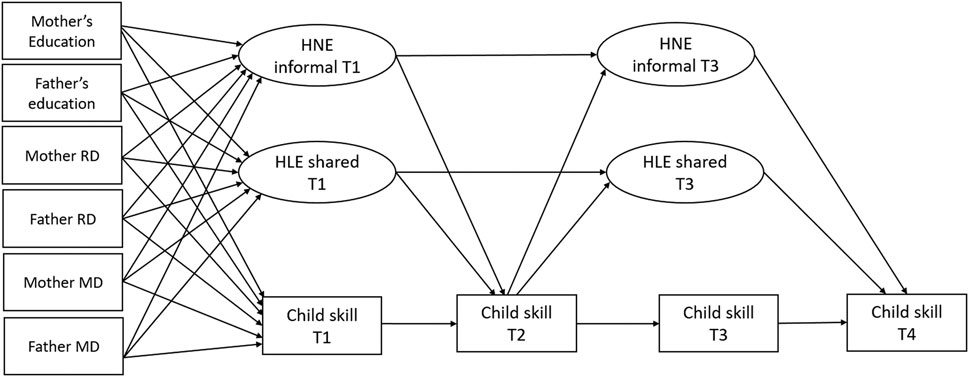
FIGURE 3. The base-model for each numeracy and language skill with direct and indirect paths. Note: In addition to the regression paths depicted, the models included residual correlations between the variables in T1 and T3. In addition, specific paths from parental skills to children’s skills were added for each individual skill model based on the step 1 models (Figures 1, 2, and Tables 3, 4).
The loadings for the HLE factors ranged between 0.665 and 0.858 at T1 and 0.597–0.806 at T3. The loadings for the HNE factors varied between 0.298 and 0.686 at T1 and 0.503–0.806 at T3. The skill assessments and parental variables were added as observed variables.
In the hypothesized model (Figure 3) we included stability paths between each skill and between the HLE and HNE factors, paths from parental variables to all T1 measures, and all cross-lagged paths between measures at subsequent time-points. In addition, specific paths from parental skills to children’s skills were added for each individual skill model based on the step 1 models (please see Figures 1, 2, and Tables 3, 4). After fitting the hypothesized model (Figure 3) the modification indices provided by Mplus were inspected to identify possible reasons for a model misfit. All paths with modification indices above 10.00 where theoretically relevant were added to the models. Finally, we performed mediation analysis by using the delta method (MacKinnon, 2008).
Results
Descriptive Statistics
Descriptive statistics for children’s skills and parental questionnaires are reported for all the participants in Table 1. The table shows the rapid development of the skills during the follow-up period for all skills measured. It also shows the considerable variability between children in the sample. Among the youngest children (T1 and T2), three symbolic measure distributions (letter knowledge, number naming, and number symbol identification) were skewed to the right, as many children did not yet have the knowledge or were still at the very beginning of grasping symbolic knowledge. Therefore, in the model estimation, we used the MLR estimator, which is robust to the skewness of the distributions.
We began our analysis by checking for entry errors and outliers. No errors were found, and the few identified outliers (over three standard deviations from the mean) were windsorized. We then examined the patterns of missing data. Little’s MCAR tests were conducted with all measures, and the missing data were found to be missing completely at random x2 (1,097) = 1,085.52, p = 0.592. In the models the missing values were handled using maximum likelihood with robust standard errors (MLR) in Mplus. Reliance on robust standard errors provides more accurate results when data are incomplete and non-normal (Savalei, 2010; Maydeu-Olivares, 2017). N = 196 in all step 2 models with direct and indirect paths.
Table 2 reports Pearson correlation coefficients between all study variables. Numeracy and literacy skills were found to be significantly correlated within and across domains from T1 onward, but the correlations became stronger over time. Similarly, HNE and HLE variables were significantly correlated with each other, and there were significant correlations with skill assessments both within and across domains. Finally, there were some significant, albeit weak, correlation coefficients between parental variables (education, parental RD, and MD), children’s skills, and home environment variables.
The Longitudinal Models
In the models constructed at the first step of our analysis (reported in Tables 3, 4), different parental variables (education, RD, and MD) were significant predictors of both children’s skills and environmental factors at different time points. The models also showed significant stability correlations in children’s skills and in HNE and HLE across time. For research question 1a on the effect of parental variables on children’s skill, please see more details for each skill in their respective models below.
Regarding the effect of parental variables (education, RD, and MD) on HLE and HNE (research question 1b), three types of effects were found. First, mothers’ education positively predicted T3 HLE (over and above HLE at T1), suggesting that the higher the mother’s education level was, the more they increased shared reading with their children from age 2.5–5.5 years. Second, the fathers’ RD predicted less shared reading at home at T1. Third, a very weak effect (which in some of the step 2 models was barely significant, and in some models fell just beneath the significance level of 0.05) was found from mothers’ RD predicting less HNE activities.
For the research question 2 on association between the home environment and children’s skills and for the research question 3 on association between children’s skills and the home environment, please see more details for each skill in their respective models below.
The Model for Counting Objects
The model for counting objects (Figure 4) had an acceptable fit with the data: x2 (199) = 240.60, p = 0.02, RMSEA = 0.03 (90% CI 0.01–0.05), CFI = 0.95, SRMR = 0.06. Of the parental variables, having a mother with MD predicted faster development in counting objects from T1 to T2. Of the home environment factors, having more informal HNE activities at T1 predicted faster development in counting objects from T1 to T2. Also, children’s poorer performance in counting objects at T2 predicted an increase in shared reading from T1 to T3.
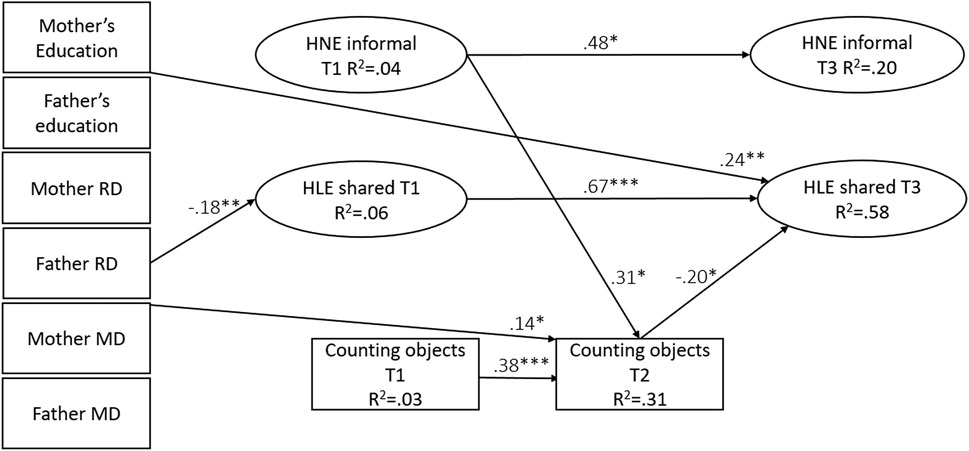
FIGURE 4. The model for counting objects skill with significant standardized estimates. Note: In addition to the regression paths depicted, there were two significant residual correlations: between HNE and HLE at T1 (stand. estimate = 0.38***) and between HNE and counting objects at T1 (stand. estimate = 0.31**).
The Model for Number Producing
The model for number producing (Figure 5) had a good fit with the data: x2 (196) = 230.17, p = 0.05, RMSEA = 0.03 (90% CI 0.00–0.04), CFI = 0.96, SRMR = 0.05. None of the parental variables predicted their children’s number producing. However, of the home environment factors, more frequent informal HNE activities at T1 predicted faster development of number-producing skills from T1 to T2. Children’s number-producing skills did not predict home environment factors.
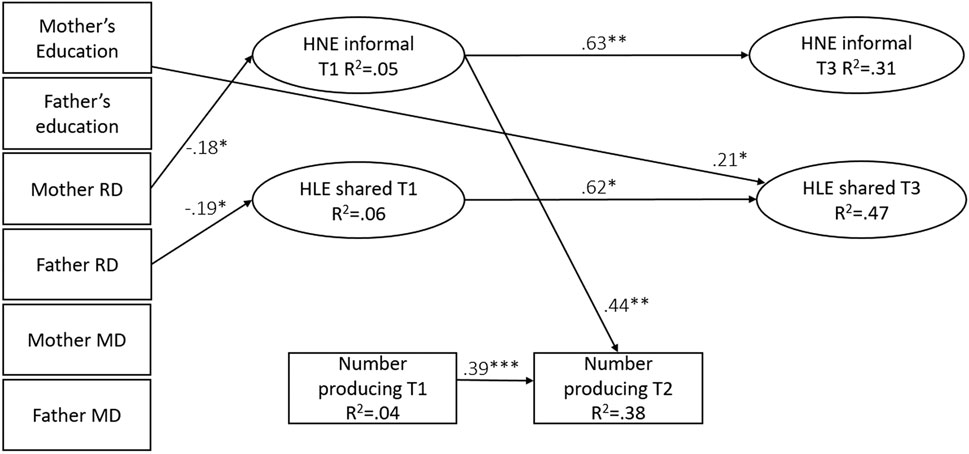
FIGURE 5. The model for number production with significant standardized estimates. Note: In addition to the regression paths depicted, there was one significant residual correlation: between HNE and HLE at T1 (stand. estimate = 0.41***).
The Model for Number Sequence Skill
The model for number sequence skill (Figure 6) had a good fit with the data: x2 (241) = 263.30, p = 0.15, RMSEA = 0.02 (90% CI 0.00–0.04), CF I = 0.98, SRMR = 0.06. Of the parental variables, fathers’ RD predicted significantly, albeit weakly, slower number sequence development from T3 to T4. No predictive associations were found between home environment factors and number sequencing skill. Children’s poorer number sequence skill at T2, however, predicted an increase in shared reading from T1 to T3.
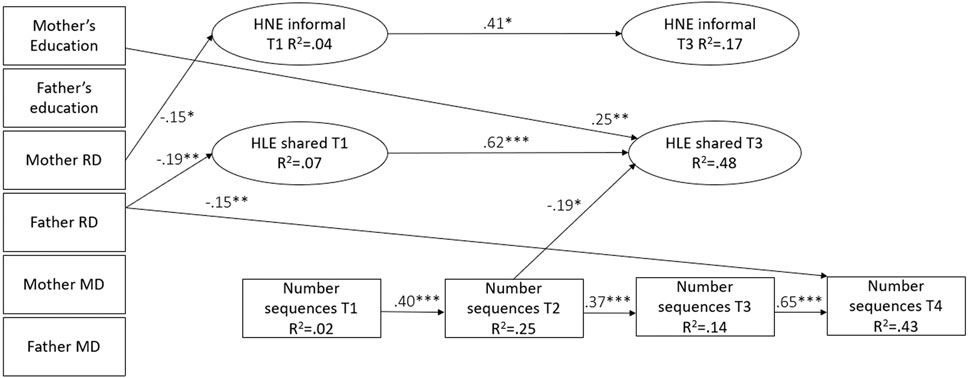
FIGURE 6. The model for number sequence skill with the significant standardized estimates. Note. In addition to the regression paths depicted, there were two significant residual correlations: between HNE and HLE at T1 (stand. estimate = 0.38***) and between HNE and number sequence skill at T1 (stand. estimate = 0.35**).
The Model for Number Symbol Identification
The model for number symbol identification (Figure 7) had a good fit with the data: x2 (238) = 266.95, p = 0.10, RMSEA = 0.02 (90% CI 0.00–0.04), CFI = 0.97, SRMR = 0.06. Of the parental variables, fathers’ MD predicted significantly, albeit weakly, their children’s number symbol identification skills. The children of the fathers who reported MD had poorer number symbol identification skills at T1 than the children whose fathers did not report MD. No predictive associations were found between home environment factors and number symbol identification. Poorer number symbol identification skills at T2, however, predicted an increase in informal HNE activities from T1 to T3.
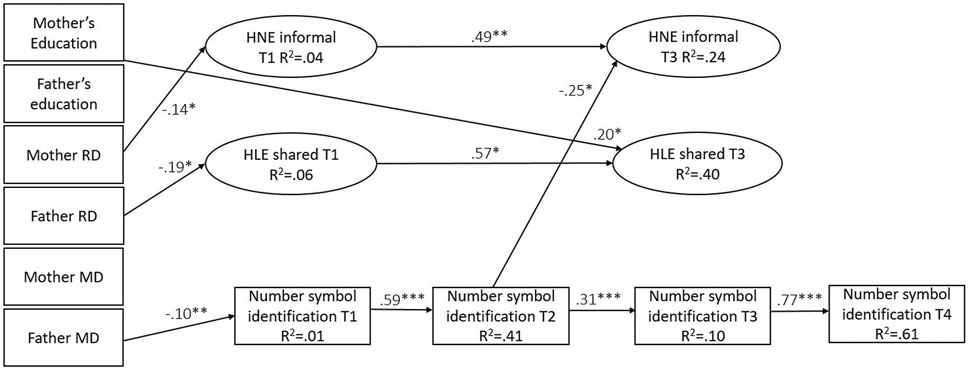
FIGURE 7. The model for number symbol identification with the significant standardized estimates. Note: In addition to the regression paths depicted, there was one significant residual correlation: between HNE and HLE at T1 (stand. estimate = 0.42***).
The Model for Number Naming
The model for number naming (Figure 8) had a good fit with the data: x2 (238) = 263.67, p = 0.12, RMSEA = 0.02 (90% CI 0.00–0.04), CFI = 0.97, SRMR = 0.06. Of the parental variables, fathers’ and mothers’ RD predicted significantly, albeit weakly, their children’s number naming at T1. The path estimates were negative, suggesting that the children with parental RD had poorer skills in number naming than their peers whose parents did not have RD. Also, fathers’ MD predicted poorer development in their children’s number naming from T3 to T4. No predictive associations were found between home environment factors and number naming skill assessments. Children’s number naming skills did not predict home environment factors.
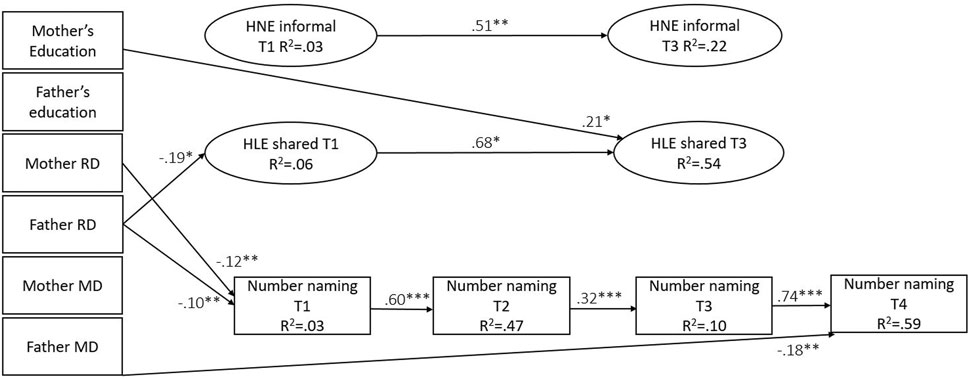
FIGURE 8. The model for number naming with the significant standardized estimates. Note: In addition to the regression paths depicted, there were two significant residual correlations: between HNE and HLE at T1 (stand. estimate = 0.41***) and between HNE and number naming skill at T1 (stand. estimate = 0.39**).
The Model for Vocabulary
The model for vocabulary (Figure 9) had a good fit with the data: x2 (242) = 279.49, p = 0.05, RMSEA = 0.03 (90% CI 0.00–0.04), CFI = 0.96, SRMR = 0.06. There were no significant associations between vocabulary and the other variables in the model.
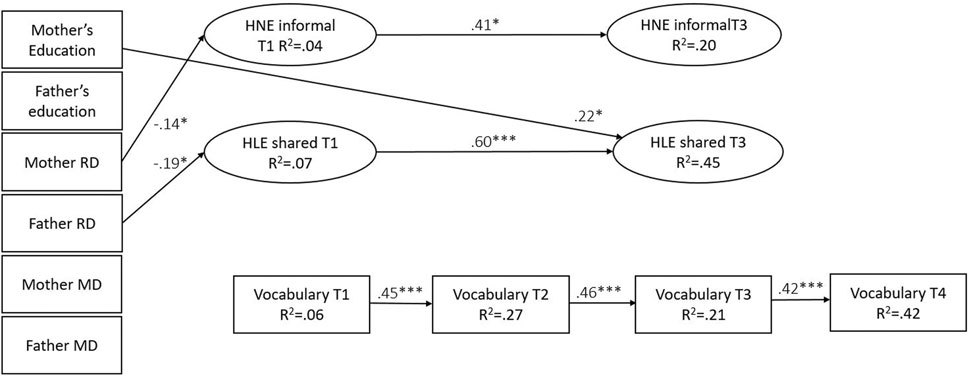
FIGURE 9. The model for vocabulary with the significant standardized estimate. Note: In addition to the regression paths depicted, there was one significant residual correlation: between HNE and HLE at T1 (stand. estimate = 0.42***).
The Model for Print Knowledge
The path model for print knowledge (Figure 10) had a good fit with the data: x2 (241) = 266.94, p = 0.12, RMSEA = 0.02 (90% CI 0.00–0.04), CFI = 0.97, SRMR = 0.06. Of the parental variables, mothers’ RD predicted significantly, albeit weakly, their children’s print knowledge at T1. The path estimate was negative, suggesting that with mothers’ RD, the children had poorer print knowledge than their peers whose mothers did not have RD. However, fathers’ RD predicted faster development in print knowledge from T3 to T4. No predictive associations were found between home environment factors and print knowledge. Children’s print knowledge did not predict home environment factors.
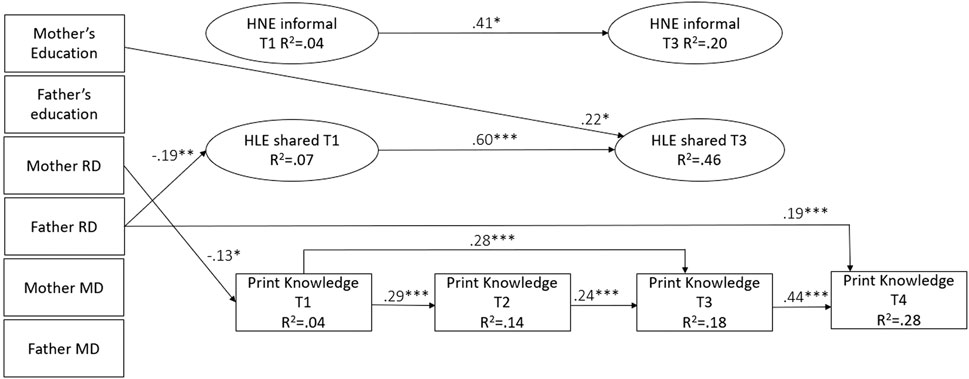
FIGURE 10. The model for print knowledge with the significant standardized estimates. Note: In addition to the regression paths depicted, there were three significant residual correlations: between HNE and HLE at T1 (stand. estimate = 0.38***) and between HNE and print knowledge at T1 (stand. estimate = 0.24*), and between HLE and print knowledge at T3 (stand. estimate = −0.27**).
The Model for Letter Knowledge
The path model for letter knowledge (Figure 11) had an acceptable fit with the data: x2 (237) = 306.26, p = 0.002, RMSEA = 0.04 (90% CI 0.02–0.05), CFI = 0.95, SRMR = 0.06. Of the parental variables, mothers’ education, fathers’ MD, and both fathers’ and mothers’ RD predicted significantly, albeit weakly, their children’s letter knowledge at T1. Fathers’ MD negatively predicted children’s letter knowledge at T3, while mothers’ MD negatively predicted children’s letter knowledge at T2. The children whose parents reported difficulties were more likely to perform worse in letter knowledge than their peers with parental RD or MD. No predictive associations were found between home environment factors and letter knowledge assessments. Children’s poorer letter knowledge at T2, however, predicted more numeracy activities at home at T3.
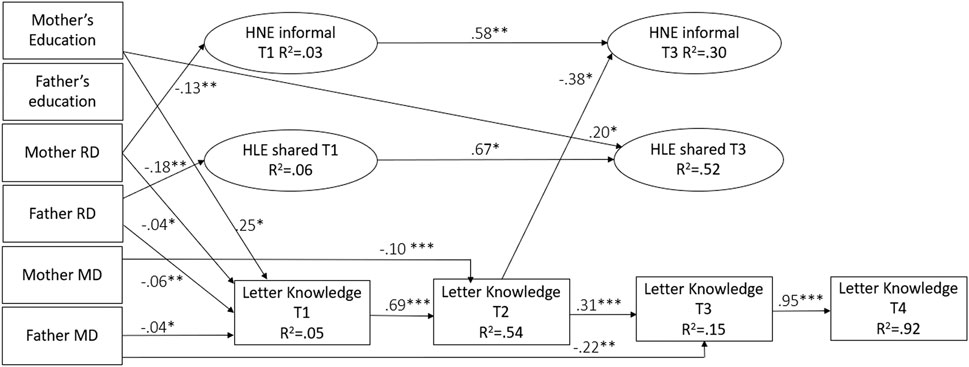
FIGURE 11. The model for letter knowledge with the significant standardized estimates. Note: In addition to the regression paths depicted, there were two significant residual correlations: between HNE and HLE at T1 (stand. estimate = 0.42***) and between HNE and letter knowledge at T1 (stand. estimate = 0.49**).
Indirect Paths
Regarding the indirect effects from parental variables on children’s numeracy and literacy development through the home environment (Research question 4), we did not find any significant mediation effects. In the step 2 models (Figures 4–11), all significant paths identified in step 1 from any of the parental measures to letter knowledge at T2-T4 became nonsignificant after adding the HLE and HNE factors at step 2. Similarly, the effects of mother’s RD on number production, number identification, and number sequences became nonsignificant after adding the HLE and HNE factors. The same was true for the effect of father’s RD on number sequences and for the effect of mother’s education on counting objects. These findings suggest that the small impact of parental measures on children’s skills may be mediated via home environment. However, none of the indirect effects from parental measures via HLE or HNE to children’s skills were found to be significant (research question 4, Table 5), which suggests that the impact of parental measures of children’s skills through home environment was not significant.
Discussion
The main objective of this study was to gain more understanding of the underpinnings of children’s early literacy and numeracy development by examining the roles of the home numeracy (HNE) and literacy (HLE) environment, parental RD and MD, and parents’ education in an early onset longitudinal sample of Finnish children (followed from age 2.5–6.5). The results showed that of the parental measures, parental RD and MD significantly, albeit weakly, predicted several of their children’s skills at different ages and both within and across domains, while parental education weakly predicted only early letter knowledge. Parental RD and MD had significantly weak negative associations with the home environment measures, while mother’s education positively predicted HLE. The HNE and HLE activities were reciprocally associated with children’s skills both within and across domains. This suggests both a supportive role for the HNE and HLE activities but underlines the role of children’s skills in arousing the activities with their parents (potentially reflecting both active and evocative gene-environment correlations).
Parental Math and Reading Difficulties and Their Education Level Predicted Children’s Numeracy and Literacy Skills
Regarding research question 1a on the role of parental measures on children’s skills, our models revealed both within-domain and cross-domain effects of parental RD and MD on children’s skills. All but two skills (number producing and vocabulary) were predicted by parental RD and/or MD. Some associations emerged as early as age 2.5: namely, mother’s RD predicting children’s T1 print knowledge, letter knowledge, and number naming skills, and father’s MD predicting T1 number symbol identification skills. At the same time, mothers’ and fathers’ RD predicted number naming at age 2.5 and fathers’ RD predicted number sequence knowledge at age 6.5. Age 2.5 letter knowledge was predicted not only by the mother’s RD but also by the father’s RD and MD. The impact of parental RD on children’s literacy skills lends support for prior studies on the significant role of FR with RD (Puolakanaho et al., 2007; Torppa et al., 2010; van Bergen et al., 2014; Esmaeeli et al., 2019). In line with Torppa et al. (2010), the results of the current study imply that the predictive role of parental RD on emerging literacy skills already exists in toddlerhood, adding a risk for children’s skill development during a sensitive period of language development. Parental MD predicted their children’s poorer symbolic numeracy processing, which is in line with prior studies (Shalev and Gross-Tsur, 2001; Soares et al., 2018). The results, however, add to the prior literature by showing a cross-domain association between parental RD and MD and emerging numeracy and literacy skills, suggesting that RD and MD have both common and distinct underpinnings (e.g., Landerl and Moll, 2010) with an early onset. Literacy and numeracy development rely on many of the same cognitive processes (Korpipää et al., 2017), but their intergenerational transfer has hardly been examined and explained.
Some effects between parental MD and children’s skills emerged later in development. Mothers’ MD predicted children’s counting skills at age 3.5, while fathers’ MD predicted children’s letter knowledge at ages 2.5 and 6.5. The results show significant within and cross-domain associations between MD and numeracy and literacy skills, which have also been found with a sample of children in primary school: In their study, Khanolainen et al. (2020) showed that parental MD predicted both children’s reading comprehension and arithmetic fluency. The findings of the current study emphasize that similar cross-domain FR might already be true before school age with children’s emerging literacy (letter and print knowledge) and numeracy (counting skills and number sequence skills). The predictive association between parental skills and children’s letter name knowledge is interesting, as letter name knowledge has been identified as a strong predictor of RD (e.g., Pennington and Lefly, 2001; Puolakanaho et al., 2007). Together, the results point to the importance of FR in children’s literacy and numeracy development well ahead of school entry, and more research is warranted on the mechanisms through which such effects emerge, particularly for the effects of parental MD, which is yet hardly investigated.
Regarding parental education, there was only one significant association with children’s skills: that of mother’s education to age 2.5 letter knowledge. This finding is in line with prior studies (e.g., Esmaeeli et al., 2018) reporting an association between parental education and children’s emergent literacy. Also, a prior Finnish study by Silinskas et al. (2020) suggested that maternal education is linked with child outcomes. In our sample, there were also other significant correlation coefficients between parental education and children’s skills, but in the models where parental RD and MD were also included, the effects of parental education became nonsignificant. This finding points to the direction that the often-reported association between parental education and their children’s skill development may be explained by parental skills, that is, the intergenerational transmission of RD and MD (e.g., van Bergen et al., 2017). In a recent study by Khanolainen et al. (2020) among school-aged children, however, parental education remained a significant predictor of children’s skill even with parental MD and RD variables in the models. Like ours, Khanolainen et al.’s (2020) study was also conducted in Finland, but the differences in sample, age, or the skills assessed may explain the difference and further studies are needed. Such studies should preferably have parental skills directly assessed instead of self-reported like the studies so far. Based on the findings, it thus appears that, of the parental measures, it is parental skills rather than their educational level underlying their children’s early skill development.
Parental Reading Difficulties and Their Education Level Predicted Home Literacy and Numeracy Environments
Regarding research question 1b, parental RD negatively predicted both HNE and HLE. The associations between fathers’ RD and the home learning environment were within-domain, whereas association for mothers’ RD appeared to impact across domains. Also, mothers’ level of education positively predicted HLE activities at T3.
First, fathers’ RD predicted less shared reading at home, thus resonating with some studies showing that children whose parents have FR of RD might be exposed to more unsupportive home environments (e.g., less shared reading) than children with parents without FR of RD (e.g., van Bergen et al., 2014; Dilnot et al., 2017). The finding can be explained by the lack of access to print materials because of parents reading less themselves, but parental attitudes or dispositions (e.g., reading anxiety) may also play a role. A recent study in foreign-language learning suggested that parents with higher levels of anxiety might engage less in HLE activities with children, thus minimizing their child’s experience in using a foreign language (Chow et al., 2017). Furthermore, studies that look closely at the reading interactions are, however, needed to understand the reasons for this association more deeply.
Second, a weak effect (which in some models was barely significant and in others fell just beneath the significance level of 0.05) was found from the mother’s RD predicting fewer HNE activities. This finding is among the first to show a predictive cross-domain association between RD and HNE. A possible explanation for the finding is that, albeit relating to numeracy in terms of content, several of the informal HNE activities used in the current study also included activities that would simultaneously require the parent to engage with and understand text or written instructions (e.g., playing board games). It was interesting to note that parental MD was not associated with HNE or HLE. Prior studies lend support for this finding; for instance, in a study by Khanolainen et al. (2020) neither RD nor MD predicted at home teaching (math and reading) or shared reading. Silinskas et al. (2010) showed that mothers’ MD predicted more frequent teaching of math (formal HNE) but not their teaching of reading (formal HLE) during the first grade in primary education. It is thus possible that also in the present sample the association would have emerged between parental MD and formal HNE had we included the formal HNE measure.
Third, mother’s education positively predicted HLE in the third time point at age 5.5 (over and above HLE at T1), suggesting that the higher the mother’s education level was, the more they increased shared reading with their children from age 2.5–5.5 years. The finding may mean that parents with higher education are themselves more accustomed to reading and find reading more pleasurable, and therefore might also be more willing to read with their children than less educated parents. Parents may also be more prone to recognize the value of reading to children. The finding is in line with a prior Finnish study linking mothers’ higher education with more shared reading and lower education with more teaching children to read (Khanolainen et al., 2020). However, their study additionally showed that lower parental education also predicted more math-related teaching at home, whereas in the current study parents’ education did not predict HNE. This finding also conflicts with that of Thompson et al. (2017), suggesting that more highly educated parents engage more frequently in numeracy activities with their 3-year-olds than parents with lower education. The lack of associations, however, could be explained again by our lack of formal teaching items and focus on informal HLE and HNE only.
Home Numeracy Environment Predicted Children’s Numeracy and Literacy Skills
As for research question 2 on the associations between HNE, HLE, and children’s skill development, our results suggested that informal HNE supports the development of several skills. However, HLE predicted neither literacy nor numeracy skills. The informal HNE at the first time point, age 2.5, positively predicted children’s counting objects skill and number producing skill at the second time point, age 3.5, even after controlling for the prior skill level at age 2.5. Similar results have been derived from recent studies about slightly older children: Skwarchuk et al. (2014) reported informal HNE predicting 5-year-old children’s nonsymbolic arithmetic, namely their abilities to manipulate quantities. However, their study was cross-sectional in terms of children’s skills. The results of the current study among younger children and with including autoregressors confirm this finding and suggest that frequently engaging in informal HNE activities, such as being exposed to numeracy-related contents in board games or measuring ingredients while cooking (e.g., Vandermaas-Peeler et al., 2012) while already in toddlerhood, may help children to gain understanding of quantity manipulation without the deliberate instruction of a symbolic number system. As nonsymbolic arithmetic skills have further been associated with better calculation and number system knowledge in later childhood (LeFevre et al., 2010), these activities may have long-standing impacts.
Unexpectedly, the home literacy environment predicted neither literacy nor numeracy skills, indicating that cross-domain associations were identified for HNE, but not for HLE. Our findings are therefore in contrast to many previous within-domain studies exploring the association between HLE and literacy skills, which suggested that more parent-child shared reading supports children’s language and literacy skills, oral language in particular (e.g., Mol and Bus, 2011:; Sénéchal and LeFevre, 2002; Torppa et al., 2007). The research also conflicts with the accumulating body of studies where both HLE and HNE, along with numeracy and literacy skills, have been inspected (e.g., Manolitsis et al., 2013; Napoli and Purpura, 2018; Khanolainen et al., 2020; Soto-Calvo et al., 2020). These studies have systematically reported significant associations between HLE and literacy and numeracy outcomes, providing well-established evidence for shared reading predicting literacy and/or numeracy outcomes, rather than the other way around. Though they showed that storybook reading predicted children’s definitional vocabulary, Napoli and Purpura (2018) also observed that the same was not true for numeracy skills: storybook reading predicted numeracy outcomes only until HNE was included in the models. Therefore, the results of their study lend only partial support to the current study in terms of explaining the importance of HNE for skill development. Many of the previous studies have not included autoregressive controls in their models (as an exception, see Khanolainen et al., 2020). Our models gave a stringent test to the hypothesis by controlling for the skill level at the previous time point. Here, we are examining if shared reading affects developing faster in each skill, not merely examining uni-directional associations.
Children’s Early Numeracy and Language Skills Predicted Home Literacy and Numeracy Environment
With respect to research question 3, our analysis revealed evocative/active effects running from children’s skills to activities with parents at home (e.g., Plomin et al., 1977; Scarr and McCartney, 1983; Pomerantz and Eaton, 2001; Rutter et al., 2006). These results add to the scarce studies by increasing understanding on how young children actively shape their learning environments by attracting responses in their home environments.
The results confirmed within-domain association, as children’s number symbol identification skill at the second time point (age 3.5) negatively predicted HNE activities at the third time point (5.5). There are three viable ways to explain the negative association. First, the results might imply that if children have poor numeracy skills, their parents are observant to this and want to do more to support the skill development (i.e., increase the frequency of informal, shared numeracy-related activities that are easily integrated into daily activities and parent-child interaction: an evocative effect on environment). A similar association has been identified in a follow-up from kindergarten through first grade: Parents of children with low math skills increased the frequency of their home numeracy activities more than others (Silinskas et al., 2020). Second, the findings could also be explained by children’s early vs. late emerging number symbol identification skills. It is noteworthy that there is a two-year gap between measuring children’s skills in time points 2 and 3. This could mean that for those children whose skills were poorer at time point 2, the skill could have emerged later during the two-year timeframe, increasing their motivation and interest toward numeracy, to which parents responded by increasing the frequency of informal HNE activities, as suggested by Silinskas et al. (2020). Third, the results could also be interpreted from the opposite perspective, implying that more skilled children (i.e., children who already identify number symbols) might lose their interest in informal HNE and attract their parents to do more complex at-home numeracy activities and formal teaching of math (e.g., teaching simple sums), which could explain the decrease in the frequency of informal HNE. This explanation can be bolstered with the findings of Thompson et al. (2017), showing that parents engage in complex, direct activities with higher frequency with 4-year-olds than 3-year-olds, suggesting that the complexity of HNE increases as children grow older. Furthermore, albeit in HLE, a similar mechanism of active effects, that is, parents teaching those children who mastered the basics of reading more often than others, was identified in a study by Silinskas et al. (2010). The results of the current study imply that a similar effect could apply to emerging numeracy skills and HNE. However, this explanation would need further research, as the current study did not include numeracy teaching items at home.
Cross-domain findings were identified for both early numeracy and literacy skills. First, children’s letter knowledge at the second time point (age 3.5) negatively predicted HNE activities at the third time point (5.5). Also, children’s skills in counting objects and number sequencing at the second time point (age 3.5) negatively predicted shared reading (HLE) at the third time point (age 5.5). A negative association could again be explained through children’s active evocative role and interest: The children whose letter knowledge skills are good might show more interest and motivation toward literacy-related tasks in the home environment, leading parents to provide less support on numeracy-related tasks and instead put more effort on literacy-related activities at home. In line with this proposition, children who are strong in number sequencing might attract more frequent numeracy-related activities with their parents and engage less in at-home activities with literacy content. Although there is an evident lack of studies having identified evocative cross-domain effects between children’s literacy and numeracy skills and HNE and HLE, this explanation of the current study could be connected to prior findings through the mechanism of parents teaching more skilled children (e.g., Silinskas et al., 2012), which with these results would extend its effects on decrease in the home activities on the other domain. These cross-domain findings imply that parents react by doing what better supports the development of their children, and that children’s active, evocative role in steering the parent’s activities is evident, although more research is needed.
No Indirect Effects From Parental RD, MD, or Educational Level on Children’s Numeracy and Literacy Development Through the Home Environment
Albeit the mediation analysis revealed that significant effects from parental measures to children’s skills (in the case of letter knowledge, number production, number identification, number sequences, and counting objects) became nonsignificant after adding the HLE and HNE factors, suggesting the impact of parental measures on children’s skill development via home environment, neither parental education nor parental RD or MD had significant indirect effects on children’s skill development via HNE or HLE (research questions 4). Consequently, our findings did not provide support for the mechanism that parental factors influence via differential home environments on children’s skill development in these families (in line with Caglar-Ryeng et al., 2020; Elbro et al., 1998; Khanolainen et al., 2020; Torppa et al., 2007; van Bergen et al., 2014). However, as our study focuses only on the frequency of informal HNE and HLE activities, it is possible there are other differences between the families with and without parental RD or MD. All the predictive effects from parental variables accounted for only a little of the variance in children’s skills, ranging from below one percent to little over four percent. Despite the small effects, the effects were still present for many skills and emerged over and above autoregressive and home environment controls, which suggests a unique role for parental RD and MD in children’s skill development. However, future studies should aim to include latent variables for all measures to manage measurement error, assess parental skills with actual skill tests, and include a broader assessment of HNE and HLE. It is also worthy of consideration to explore the role of other environments, such as enrollment in institutional ECEC, where emerging literacy skills and abilities in integrating numeracy into several daily activities are more systematically emerging in children’s lives.
Limitations and Future Directions
This study is not without its limitations, with most relating to measures used. First, for children’s emerging numeracy skills, we did not have nonsymbolic measures albeit evidence exists on the importance of approximate number system, for development of symbolic numerical skills (e.g., Feigenson et al., 2013). Despite that our existing symbolic measures yielded significant associations with FR, HLE, and HNE measures, it would nevertheless be important to include nonsymbolic tasks to future studies. Furthermore, we were not able to calculate reliabilities for all of the children’s measures, particularly so for the numeracy measures. This is because the tasks items become increasingly difficult as the test progresses, and due to the discontinuation rules in place, not all the children completed all the items. Therefore, calculation of the Cronbach alpha, which is a measure of item cohesion within a test, is not meaningful and becomes impossible to calculate due to missingness by test design. If we only use the items that all children have responses, we do not have enough variation to calculate meaningful reliability indices. In our data, the time-gap is also too long for the calculation of test-re-test reliabilities. Second, this study deployed single measures for parental RD and MD and children’s literacy and numeracy skills. Although we included HNE and HLE into the models as latent factors and thus minimized measurement error, the same was thus impossible for the other constructs. For children’s skills, it was impossible to form similar latent factors across time because of varying correlation patterns. This was also expected, as we assessed several early number skills that theoretically emerge as more distinct skills in the early development with integration occurring later in development (e.g., Purpura et al., 2017b). As we wished to control for the autoregressive effects, the estimation of separate models for each skill seemed inevitable. Third, the assessment of parental RD and MD was based on single-item self-reports. This is not ideal, as self-reports may be affected by the individual’s reference group, his or her educational and occupational pathways, or the positivity/negativity of views on self the individual has in general. Therefore, in future studies, we recommend the use of direct parental skill assessments, as they have been shown to predict children’s skill development (e.g., Puglisi et al., 2017). If that is impossible, use of a more detailed questionnaire with multiple items on the specific difficulties one may face with RD or MD is recommended (e.g., Pennington and Lefly, 2001).
Fourth, HNE and HLE measures were based on parental reported activities at home. Questionnaire-based assessments are limited and threatened by bias due to over-reporting of activities, but parents may also have difficulties accurately identifying the frequency of these activities in the home (Elliot and Bachman, 2018). All HNE and HLE activities were focused on the informal home environment, and we recognize that there may be other environmental influences at home affecting children’s skills. Such factors could be the direct teaching of numeracy and literacy skills, which in prior studies have been associated with both literacy (e.g., Sénéchal and LeFevre, 2002; Sénéchal and LeFevre, 2014) and numeracy skills (e.g., Skwarchuk et al., 2014), especially with older children. Future studies should also include complex formal teaching activities to better understand the full impact of home environment activities, especially because studies combining formal and informal HNE and HLE in an early onset study are basically nonexistent. Also, all the items of HLE and HNE were based on shared parent-child activities. Such items are the most influential regarding children’s skill development (Melhuish et al., 2008), but it may be that access to literacy and numeracy content (e.g., frequency of library visits, amount of books, and other play materials) should have also been assessed. Nevertheless, the current sample comes from Finland and participated in ECEC, where children have solid access to print and numbers. However, in some other contexts or samples, children may be more deprived of opportunities to get access to materials (no access to a library, no games or books at home), and that can be detrimental to their learning opportunities. The sheer access or even frequency of interactions may not be enough if the quality of interactions is not sufficient. In this study, we did not include interaction quality measures, which could provide a better understanding of what aspects of HLE and HNE support children’s skill development. Future studies should therefore complement the inspection of the home learning environment with observations (e.g., Totsika and Sylva, 2004) focusing on the quality of the home environment alongside the quantity. Fifth, children and families were recruited from a relatively limited geographical area (one municipality), with a rather high proportion of highly educated parents; therefore, it would be preferable to replicate the study in a more representative sample.
Future studies examining the underpinnings of early literacy and numeracy development should also consider the impact of literacy and numeracy environments in formal ECEC. Although the number of ECEC children under 3 years old is lower in Finland than in the OECD countries on average (European Commission/EACEA/Eurydice/Eurostat, 2019), exposure to a more formal instructional environment alongside the home environment plays an important supportive role in developing both emerging literacy and numeracy skills (Anders et al., 2012). Based on the findings of the current study, this might be important for children with FR for RD or MD.
Conclusion
Overall, the current study suggests that the associations between parental measures, home environments, and young children’s developing literacy and numeracy skills emerge as early as toddlerhood. It is also of importance to note that at this important developmental stage, the associations between the growing child and his or her home environment were reciprocal and not limited to within-domain effects. It thus appears that the early risk factors for RD and MD regarding measures of home environment and parental skills are at least partially shared years before school entry and might give at least a partial explanation for the rather high covariance and comorbid problems in reading and math later on.
Data Availability Statement
The raw data supporting the conclusion of this article will be made available by the authors, without undue reservation.
Ethics Statement
The studies involving human participants were conducted under the regimes and regulations of the Ethical Committee of the University of Jyväskylä and the Finnish Advisory Board on Research Integrity (2012). Written informed consent to participate in this study was provided by the children’s legal guardian/next of kin. Parents gave informed consent regarding their own participation.
Author Contributions
JS wrote the first draft of the manuscript. DK and MT conducted the data analysis, and TK and JS contributed to planning and preparing the data for analysis. JS and M-KL were responsible for the research design and data collection. All authors actively contributed to deciding the research design, the manuscript writing and editing, and all authors read and approved the submitted version.
Funding
JS was supported by a grant from the Academy of Finland # 308070. DK has received funding from the European Union’s Horizon 2020 Research and Innovation Programme Neo-PRISM-C under the Marie Skłodowska Curie grant agreement # 813546. Also, MT, TK and JS have received funding from the European Research Council (ERC) under the European Union’s Horizon 2020 research and innovation programme (Grant agreement No 101002966).
Conflict of Interest
The authors declare that the research was conducted in the absence of any commercial or financial relationships that could be construed as a potential conflict of interest.
Publisher’s Note
All claims expressed in this article are solely those of the authors and do not necessarily represent those of their affiliated organizations, or those of the publisher, the editors and the reviewers. Any product that may be evaluated in this article, or claim that may be made by its manufacturer, is not guaranteed or endorsed by the publisher.
References
Anders, Y., Rossbach, H.-G., Weinert, S., Ebert, S., Kuger, S., Lehrl, S., et al. (2012). Home and Preschool Learning Environments and Their Relations to the Development of Early Numeracy Skills. Early Child. Res. Q. 27 (2), 231–244. doi:10.1016/j.ecresq.2011.08.003
Baker, C. E. (2014). African American Fathers' Contributions to Children's Early Academic Achievement: Evidence from Two-Parent Families from the Early Childhood Longitudinal Study-Birth Cohort. Early Educ. Develop. 25, 19–35. doi:10.1080/10409289.2013.764225
Blevins‐Knabe, B., and Musun‐Miller, L. (1996). Number Use at home by Children and Their Parents and its Relationship to Early Mathematical Performance. Early Develop. Parenting: Int. J. Res. Pract. 5 (1), 35–45. doi:10.1002/(SICI)1099-0917(199603)5:1<35:AID-EDP113>3.0.CO;2-0
Caglar‐Ryeng, Ø., Eklund, K., and Nergård‐Nilssen, T. (2020). The Effects of Book Exposure and reading Interest on Oral Language Skills of Children with and without a Familial Risk of Dyslexia. Dyslexia 26 (4), 394–410. doi:10.1002/dys.1657
Chow, B. W.-Y., Chui, B. H.-T., Lai, M. W.-C., and Kwok, S. Y. C. L. (2017). Differential Influences of Parental home Literacy Practices and Anxiety in English as a Foreign Language on Chinese Children's English Development. Int. J. Bilingual Educ. Bilingualism 20, 625–637. doi:10.1080/13670050.2015.1062468
Chu, F. W., vanMarle, K., Rouder, J., and Geary, D. C. (2018). Children's Early Understanding of Number Predicts Their Later Problem-Solving Sophistication in Addition. J. Exp. Child. Psychol. 169, 73–92. doi:10.1016/j.jecp.2017.12.010
Daucourt, M. C., Napoli, A., Quinn, J. M., Wood, S. G., and Hart, S. A. (2021, The Home Math Environment and Children's Math Achievement: A Meta-Analysis). PsyArXiv. May 25. doi:10.31234/osf.io/n4b2a
Davidse, N. J., De Jong, M. T., and Bus, A. G. (2014). Explaining Common Variance Shared by Early Numeracy and Literacy. Read. Writ 27, 631–648. doi:10.1007/s11145-013-9465-0
de Zeeuw, E. L., de Geus, E. J. C., and Boomsma, D. I. (2015). Meta-analysis of Twin Studies Highlights the Importance of Genetic Variation in Primary School Educational Achievement. Trends Neurosci. Educ. 4, 69–76. doi:10.1016/j.tine.2015.06.001
DeFlorio, L., and Beliakoff, A. (2015). Socioeconomic Status and Preschoolers' Mathematical Knowledge: The Contribution of home Activities and Parent Beliefs. Early Educ. Develop. 26 (3), 319–341. doi:10.1080/10409289.2015.968239
Dilnot, J., Hamilton, L., Maughan, B., and Snowling, M. J. (2017). Child and Environmental Risk Factors Predicting Readiness for Learning in Children at High Risk of Dyslexia. Dev. Psychopathol 29, 235–244. doi:10.1017/S0954579416000134
Dunn, L., and Dunn, L. (1981). The Peabody Picture Vocabulary Test-Revised. Circle Pines, MN: American Guidance Service.
Elbro, C., Borstrøm, I., and Petersen, D. K. (1998). Predicting Dyslexia from Kindergarten: The Importance of Distinctness of Phonological Representations of Lexical Items. Reading Res. Q. 33, 36–60. doi:10.1598/RRQ.33.1.3
Elliott, L., and Bachman, H. J. (2018). How Do Parents foster Young Children's Math Skills? Child. Dev. Perspect. 12, 16–21. doi:10.1111/cdep.12249
Esmaeeli, Z., Lundetrae, K., and Kyle, F. E. (2018). What Can Parents' Self-Report of Reading Difficulties Tell Us about Their Children's Emergent Literacy at School Entry? Dyslexia 24, 84–105. doi:10.1002/dys.1571
Esmaeeli, Z., Kyle, F. E., and Lundetræ, K. (2019). Contribution of Family Risk, Emergent Literacy and Environmental Protective Factors in Children's reading Difficulties at the End of Second-Grade. Read. Writ 32 (9), 2375–2399. doi:10.1007/s11145-019-09948-5
European Commission/EACEA/Eurydice (2019). Key Data on Early Childhood Education and Care in Europe. Eurydice Report. 2019 Edition. Luxembourgh: Publications Office of the European Union. Available at: https://ec.europa.eu/eurostat/documents/3217494/5785249/EC-01-14-484-EN.PDF/cbdf1804-a139-43a9-b8f1ca5223eea2a1.
Evans, M. A., and Shaw, D. (2008). Home Grown for reading: Parental Contributions to Young Children's Emergent Literacy and Word Recognition. Can. Psychology/Psychologie Canadienne 49, 89–95. doi:10.1037/0708-5591.49.2.89
Feigenson, L., Libertus, M. E., and Halberda, J. (2013). Links between the Intuitive Sense of Number and Formal Mathematics Ability. Child. Dev. Perspect. 7 (2), 74–79. doi:10.1111/cdep.12019
Geary, D. C., vanMarle, K., Chu, F. W., Rouder, J., Hoard, M. K., and Nugent, L. (2018). Early Conceptual Understanding of Cardinality Predicts Superior School-Entry Number-System Knowledge. Psychol. Sci. 29, 191–205. doi:10.1177/0956797617729817
Gerber, R. J., Wilks, T., and Erdie-Lalena, C. (2010). Developmental Milestones: Motor Development. Pediatr. Rev. 31, 267–277. doi:10.1542/pir.31-7-267
Hamilton, L. G., Hayiou-Thomas, M. E., Hulme, C., and Snowling, M. J. (2016). The home Literacy Environment as a Predictor of the Early Literacy Development of Children at Family-Risk of Dyslexia. Sci. Stud. Read. 20 (5), 401–419. doi:10.1080/10888438.2016.1213266
Hannula, M. M., and Lehtinen, E. (2005). Spontaneous Focusing on Numerosity and Mathematical Skills of Young Children. Learn. Instruction 15 (3), 237–256. doi:10.1016/j.learninstruc.2005.04.005
Hart, S. A., Ganley, C. M., and Purpura, D. J. (2016). Understanding the Home Math Environment and its Role in Predicting Parent Report of Children's Math Skills. PloS one 11, e0168227. doi:10.1371/journal.pone.0168227
Hart, S. A., Petrill, S. A., DeThorne, L. S., Deater-Deckard, K., Thompson, L. A., Schatschneider, C., et al. (2009). Environmental Influences on the Longitudinal Covariance of Expressive Vocabulary: Measuring the home Literacy Environment in a Genetically Sensitive Designfluences on the Longitudinal Covariance of Expressive Vocabulary: Measuring the home Literacy Environment in a Genetically Sensitive Design. J. Child. Psychol. Psychiatry 50, 911–919. doi:10.1111/j.1469-7610.2009.02074.x
Hjetland, H. N., Brinchmann, E. I., Scherer, R., Hulme, C., and Melby-Lervåg, M. (2020). Preschool Pathways to reading Comprehension: A Systematic Meta-Analytic Review. Educ. Res. Rev. 30, 100323. doi:10.1016/j.edurev.2020.100323
Hulme, C., Nash, H. M., Gooch, D., Lervåg, A., and Snowling, M. J. (2015). The Foundations of Literacy Development in Children at Familial Risk of Dyslexia. Psychol. Sci. 26 (12), 1877–1886. doi:10.1177/0956797615603702
Khanolainen, D., Psyridou, M., Silinskas, G., Lerkkanen, M. K., Niemi, P., Poikkeus, A. M., et al. (2020). Longitudinal Effects of the Home Learning Environment and Parental Difficulties on Reading and Math Development across Grades 1-9. Front. Psychol. 11, 577981. doi:10.3389/fpsyg.2020.577981
Kleemans, T., Peeters, M., Segers, E., and Verhoeven, L. (2012). Child and home Predictors of Early Numeracy Skills in Kindergarten. Early Child. Res. Q. 27 (3), 471–477. doi:10.1016/j.ecresq.2011.12.004
Knafo, A., and Jaffee, S. R. (2013). Gene-environment Correlation in Developmental Psychopathology. Dev. Psychopathol 25, 1–6. doi:10.1017/S0954579412000855
Koponen, T., Aunola, K., and Nurmi, J.-E. (2019). Verbal Counting Skill Predicts Later Math Performance and Difficulties in Middle School. Contemp. Educ. Psychol. 59, 101803. doi:10.1016/j.cedpsych.2019.101803
Koponen, T., Salmi, P., Torppa, M., Eklund, K., Aro, T., Aro, M., et al. (2016). Counting and Rapid Naming Predict the Fluency of Arithmetic and reading Skills. Contemp. Educ. Psychol. 44-45, 83–94. doi:10.1016/j.cedpsych.2016.02.004
Korpipää, H., Koponen, T., Aro, M., Tolvanen, A., Aunola, K., Poikkeus, A.-M., et al. (2017). Covariation between reading and Arithmetic Skills from Grade 1 to Grade 7. Contemp. Educ. Psychol. 51, 131–140. doi:10.1016/j.cedpsych.2017.06.005
Korpipää, H., Moll, K., Aunola, K., Tolvanen, A., Koponen, T., Aro, M., et al. (2020). Early Cognitive Profiles Predicting reading and Arithmetic Skills in Grades 1 and 7. Contemp. Educ. Psychol. 60, 101830. doi:10.1016/j.cedpsych.2019.101830
Landerl, K., and Moll, K. (2010). Comorbidity of Learning Disorders: Prevalence and Familial Transmission. J. Child. Psychol. Psychiatry 51 (3), 287–294. doi:10.1111/j.1469-7610.2009.02164.x
LeFevre, J.-A., Skwarchuk, S.-L., Smith-Chant, B. L., Fast, L., Kamawar, D., and Bisanz, J. (2009). Home Numeracy Experiences and Children's Math Performance in the Early School Years. Can. J. Behav. Science/Revue canadienne des Sci. du comportement 41, 55–66. doi:10.1037/a0014532
LeFevre, J. A., Fast, L., Skwarchuk, S. L., Smith-Chant, B. L., Bisanz, J., Kamawar, D., et al. (2010). Pathways to Mathematics: Longitudinal Predictors of Performance. Child. Dev. 81 (6), 1753–1767. doi:10.1111/j.1467-8624.2010.01508.x
Lerkkanen, M.-K., Poikkeus, A.-M., and Ketonen, R. (2006). ARMI—Luku- Ja Kirjoitustaidon Arviointimateriaali 1.Luokalle [ARMI—A Tool for Assessing reading and Writing Skills in Grade 1. Helsinki, Finland: WSOY.
Lerkkanen, M.-K., and Salminen, J. (2015–2019). Interaction, Development & Learning (VUOKKO) Study. Unpublished data. Finland: University of Jyväskylä.
Levin, I., Levy-Shiff, R., Appelbaum-Peled, T., Katz, I., Komar, M., and Meiran, N. (1997). Antecedents and Consequences of Maternal Involvement in Children's Homework: A Longitudinal Analysis. J. Appl. Dev. Psychol. 18, 207–227. doi:10.1016/S0193-3973(97)90036-8
Lohvansuu, K., Torppa, M., Ahonen, T., Eklund, K., Hämäläinen, J. A., Leppänen, P. H. T., et al. (2021). Unveiling the Mysteries of Dyslexia-Lessons Learned from the Prospective Jyväskylä Longitudinal Study of Dyslexia. Brain Sci. 11, 427. doi:10.3390/brainsci11040427
Lonigan, C. J., Wagner, R. K., Torgesen, J. K., and Rashotte, C. A. (2007). TOPEL: Test of Preschool Early Literacy. Austin: TX: Pro.
MacKinnon, D. P. (2008). Introduction to Statistical Mediation Analysis. New York: Lawrence Erlbaum Associates.
Manolitsis, G., Georgiou, G. K., and Tziraki, N. (2013). Examining the Effects of home Literacy and Numeracy Environment on Early reading and Math Acquisition. Early Child. Res. Q. 28 (4), 692–703. doi:10.1016/j.ecresq.2013.05.004
Maydeu-Olivares, A. (2017). Maximum Likelihood Estimation of Structural Equation Models for Continuous Data: Standard Errors and Goodness of Fit. Struct. Equation Model. A Multidisciplinary J. 24, 383–394. doi:10.1080/10705511.2016.126960610.1080/10705511.2016.1269606
Melhuish, E. C., Phan, M. B., Sylva, K., Sammons, P., Siraj-Blatchford, I., and Taggart, B. (2008). Effects of the home Learning Environment and Preschool center Experience upon Literacy and Numeracy Development in Early Primary School. J. Soc. Issues 64, 95–114. doi:10.1111/j.1540-4560.2008.00550.x
Missall, K., Hojnoski, R. L., Caskie, G. I. L., and Repasky, P. (2015). Home Numeracy Environments of Preschoolers: Examining Relations Among Mathematical Activities, Parent Mathematical Beliefs, and Early Mathematical Skills. Early Educ. Develop. 26, 356–376. doi:10.1080/10409289.2015.968243
Mol, S. E., and Bus, A. G. (2011). To Read or Not to Read: a Meta-Analysis of Print Exposure from Infancy to Early Adulthood. Psychol. Bull. 137, 267–296. doi:10.1037/a0021890
Moll, K., Landerl, K., Snowling, M. J., and Schulte-Körne, G. (2019). Understanding Comorbidity of Learning Disorders: Task-dependent Estimates of Prevalence. J. Child. Psychol. Psychiatry 60 (3), 286–294. doi:10.1111/jcpp.12965
Mutaf Yıldız, B., Sasanguie, D., De Smedt, B., and Reynvoet, B. (2018). Frequency of home Numeracy Activities Is Differentially Related to Basic Number Processing and Calculation Skills in Kindergartners. Front. Psychol. 9, 340. doi:10.3389/fpsyg.2018.00340
Mutaf-Yıldız, B., Sasanguie, D., De Smedt, B., and Reynvoet, B. (2020). Probing the Relationship between home Numeracy and Children's Mathematical Skills: A Systematic Review. Front. Psychol. 11, 2074. doi:10.3389/fpsyg.2020.02074
Napoli, A. R., and Purpura, D. J. (2018). The home Literacy and Numeracy Environment in Preschool: Cross-Domain Relations of Parent-Child Practices and Child Outcomes. J. Exp. Child. Psychol. 166, 581–603. doi:10.1016/j.jecp.2017.10.002
Niklas, F., and Schneider, W. (2014). Casting the die before the die is cast: The importance of the home numeracy environment for preschool children. Eur. J. Psychol. Educ. 29 (3), 327–345. doi:10.1007/s10212-013-0201-6
Pennington, B. F., and Lefly, D. L. (2001). Early reading Development in Children at Family Risk for Dyslexia. Child. Dev. 72, 816–833. doi:10.1111/1467-8624.00317
Petrill, S. A., Deater-Deckard, K., Schatschneider, C., and Davis, C. (2005). Measured Environmental Influences on Early reading: Evidence from an Adoption Study. Scientific Stud. Reading 9 (3), 237–259. doi:10.1207/s1532799xssr0903_4
Plomin, R., DeFries, J. C., and Loehlin, J. C. (1977). Genotype-environment Interaction and Correlation in the Analysis of Human Behavior. Psychol. Bull. 84 (2), 309–322. doi:10.1037/0033-2909.84.2.309
Pomerantz, E. M., and Eaton, M. M. (2001). Maternal Intrusive Support in the Academic Context: Transactional Socialization Processes. Dev. Psychol. 37 (2), 174–186. doi:10.1037/0012-1649.37.2.174
Psyridou, M., Eklund, K., Poikkeus, A. M., and Torppa, M. (2018). Reading Outcomes of Children with Delayed Early Vocabulary: A Follow-Up from Age 2-16. Res. Dev. Disabil. 78, 114–124. doi:10.1016/j.ridd.2018.05.004
Puglisi, M. L., Hulme, C., Hamilton, L. G., and Snowling, M. J. (2017). The Home Literacy Environment Is a Correlate, but Perhaps Not a Cause, of Variations in Children's Language and Literacy Development. Sci. Stud. Read. 21, 498–514. doi:10.1080/10888438.2017.1346660
Puolakanaho, A., Ahonen, T., Aro, M., Eklund, K., Leppänen, P. H., Poikkeus, A. M., et al. (2007). Very Early Phonological and Language Skills: Estimating Individual Risk of reading Disability. J. Child. Psychol. Psychiatry 48 (9), 923–931. doi:10.1111/j.1469-7610.2007.01763.x
Purpura, D. J., and Ganley, C. M. (2014). Working Memory and Language: Skill-specific or Domain-General Relations to Mathematics? J. Exp. Child. Psychol. 122, 104–121. doi:10.1016/j.jecp.2013.12.009
Purpura, D. J., Hume, L. E., Sims, D. M., and Lonigan, C. J. (2011). Early Literacy and Early Numeracy: the Value of Including Early Literacy Skills in the Prediction of Numeracy Development. J. Exp. Child. Psychol. 110, 647–658. doi:10.1016/j.jecp.2011.07.004
Purpura, D. J., Logan, J. A. R., Hassinger-Das, B., and Napoli, A. R. (2017b). Why Do Early Mathematics Skills Predict Later reading? the Role of Mathematical Language. Dev. Psychol. 53 (9), 1633–1642. doi:10.1037/dev0000375
Purpura, D. J., Schmitt, S. A., and Ganley, C. M. (2017a). Foundations of Mathematics and Literacy: The Role of Executive Functioning Components. J. Exp. Child. Psychol. 153, 15–34. doi:10.1016/j.jecp.2016.08.010
Purpura, D. J., and Reid, E. E. (2016). Mathematics and Language: Individual and Group Differences in Mathematical Language Skills in Young Children. Early Child. Res. Q. 36, 259–268. doi:10.1016/j.ecresq.2015.12.020
Rutter, M., Moffitt, T. E., and Caspi, A. (2006). Gene-environment Interplay and Psychopathology: Multiple Varieties but Real Effects. J. Child. Psychol. Psychiatry 47, 226–261. doi:10.1111/j.1469-7610.2005.01557.x
Savalei, V. (2010). Expected versus Observed Information in SEM with Incomplete normal and Nonnormal Data. Psychol. Methods 15, 352–367. doi:10.1037/a0020143
Scarborough, H. S., and Dobrich, W. (1994). On the Efficacy of reading to Preschoolers. Dev. Rev. 14 (3), 245–302. doi:10.1006/drev.1994.1010
Scarr, S., and McCartney, K. (1983). How People Make Their Own Environments: a Theory of Genotype Greater Than Environment Effects. Child. Dev. 54 (2), 424–435. doi:10.2307/112970310.1111/j.1467-8624.1983.tb03884.x
Schneider, M., Beeres, K., Coban, L., Merz, S., Susan Schmidt, S., Stricker, J., et al. (2017). Associations of Non-symbolic and Symbolic Numerical Magnitude Processing with Mathematical Competence: a Meta-Analysis. Dev. Sci. 20, 3. doi:10.1111/desc.12372
Sénéchal, M., and Lefevre, J. A. (2014). Continuity and Change in the home Literacy Environment as Predictors of Growth in Vocabulary and reading. Child. Dev. 85, 1552–1568. doi:10.1111/cdev.12222
Sénéchal, M., and Lefevre, J. A. (2002). Parental Involvement in the Development of Children's reading Skill: a Five-Year Longitudinal Studyfive-Year Longitudinal Study. Child. Dev. 73, 445–460. doi:10.1111/1467-8624.00417
Sénéchal, M., Pagan, S., Lever, R., and Ouellette, G. P. (2008). Relations Among the Frequency of Shared Reading and 4-Year-Old Children's Vocabulary, Morphological and Syntax Comprehension, and Narrative Skills. Early Educ. Develop. 19, 27–44. doi:10.1080/10409280701838710
Sénéchal, M. (2006). Testing the Home Literacy Model: Parent Involvement in Kindergarten Is Differentially Related to Grade 4 Reading Comprehension, Fluency, Spelling, and Reading for Pleasurefferentially Related to Grade 4 reading Comprehension Fluency, Spelling and reading for Pleasure. Scientific Stud. Reading 10, 59–87. doi:10.1207/s1532799xssr1001_4
Shalev, R. S., and Gross-Tsur, V. (2001). Developmental Dyscalculia. Pediatr. Neurol. 24, 337–342. doi:10.1016/s0887-8994(00)00258-7
Silinskas, G., Di Lonardo, S., Douglas, H., Xu, C., LeFevre, J.-A., Garckija, R., et al. (2020). Responsive home Numeracy as Children Progress from Kindergarten through Grade 1. Early Child. Res. Q. 53, 484–495. doi:10.1016/j.ecresq.2020.06.003
Silinskas, G., Leppänen, U., Aunola, K., Parrila, R., and Nurmi, J.-E. (2010). Predictors of Mothers' and Fathers' Teaching of reading and Mathematics during Kindergarten and Grade 1. Learn. Instruction 20, 61–71. doi:10.1016/j.learninstruc.2009.01.002
Silinskas, G., Lerkkanen, M.-K., Tolvanen, A., Niemi, P., Poikkeus, A.-M., and Nurmi, J.-E. (2012). The Frequency of Parents' reading-related Activities at home and Children's reading Skills during Kindergarten and Grade 1. J. Appl. Dev. Psychol. 33 (6), 302–310. doi:10.1016/j.appdev.2012.07.004
Silinskas, G., Niemi, P., Lerkkanen, M.-K., and Nurmi, J.-E. (2013). Children's Poor Academic Performance Evokes Parental Homework Assistance-But Does it Help? Int. J. Behav. Develop. 37, 44–56. doi:10.1177/0165025412456146
Silver, A. M., Elliott, L., Imbeah, A., and Libertus, M. E. (2020). Understanding the Unique Contributions of home Numeracy, Inhibitory Control, the Approximate Number System, and Spontaneous Focusing on Number for Children's Math Abilities. Math. Think Learn. 22 (4), 296–311. doi:10.1080/10986065.2020.1818469
Skwarchuk, S.-L. (2009). How Do Parents Support Preschoolers' Numeracy Learning Experiences at Home? Early Child. Educ J 37 (3), 189–197. doi:10.1007/s10643-009-0340-1
Skwarchuk, S. L., Sowinski, C., and LeFevre, J. A. (2014). Formal and Informal home Learning Activities in Relation to Children's Early Numeracy and Literacy Skills: the Development of a home Numeracy Model. J. Exp. Child. Psychol. 121, 63–84. doi:10.1016/j.jecp.2013.11.006
Snowling, M. J., and Melby-Lervåg, M. (2016). Oral Language Deficits in Familial Dyslexia: A Meta-Analysis and Review. Psychol. Bull. 142 (5), 498–545. doi:10.1037/bul0000037
Soares, N., Evans, T., and Patel, D. R. (2018). Specific Learning Disability in Mathematics: a Comprehensive Review. Transl Pediatr. 7, 48–62. doi:10.21037/tp.2017.08.03
Soodla, P., Lerkkanen, M.-K., Niemi, P., Kikas, E., Silinskas, G., and Nurmi, J.-E. (2015). Does Early Reading Instruction Promote the Rate of Acquisition? A Comparison of Two Transparent Orthographies. Learn. Instruction 38, 14–23. doi:10.1016/j.learninstruc.2015.02.002
Soto-Calvo, E., Simmons, F. R., Adams, A.-M., Francis, H. N., and Giofre, D. (2020). Pre-Schoolers' Home Numeracy and Home Literacy Experiences and Their Relationships with Early Number Skills: Evidence from a UK Study. Early Educ. Develop. 31, 113–136. doi:10.1080/10409289.2019.1617012
Susperreguy, M. I., Di Lonardo Burr, S., Xu, C., Douglas, H., and LeFevre, J. A. (2020). Children's Home Numeracy Environment Predicts Growth of Their Early Mathematical Skills in Kindergarten. Child. Dev. 91 (5), 1663–1680. doi:10.1111/cdev.13353
Thompson, R. J., Napoli, A. R., and Purpura, D. J. (2017). Age-related Differences in the Relation between the home Numeracy Environment and Numeracy Skills. Inf. Child. Dev. 26, e2019. doi:10.1002/icd.2019
Torppa, M., Eklund, K., van Bergen, E., and Lyytinen, H. (2015). Late-emerging and Resolving Dyslexia: A Follow-Up Study from Age 3 to 14. J. Abnorm Child. Psychol. 43 (7), 1389–1401. doi:10.1007/s10802-015-0003-1
Torppa, M., Lyytinen, P., Erskine, J., Eklund, K., and Lyytinen, H. (2010). Language Development, Literacy Skills, and Predictive Connections to reading in Finnish Children with and without Familial Risk for Dyslexia. J. Learn. Disabil. 43 (4), 308–321. doi:10.1177/0022219410369096
Torppa, M., Poikkeus, A. M., Laakso, M. L., Eklund, K., and Lyytinen, H. (2006). Predicting Delayed Letter Knowledge Development and its Relation to Grade 1 reading Achievement Among Children with and without Familial Risk for Dyslexia. Dev. Psychol. 42 (6), 1128–1142. doi:10.1037/0012-1649.42.6.1128
Torppa, M., Poikkeus, A.-M., Laakso, M.-L., Tolvanen, A., Leskinen, E., Leppänen, P. H. T., et al. (2007). Modeling the Early Paths of Phonological Awareness and Factors Supporting its Development in Children with and without Familial Risk of Dyslexia. Scientific Stud. Reading 11, 73–103. doi:10.1080/10888430709336554
Totsika, V., and Sylva, K. (2004). The home Observation for Measurement of the Environment Revisited. Child. Adolesc. Ment. Health 9, 25–35. doi:10.1046/j.1475-357X.2003.00073.x
van Bergen, E., van der Leij, A., and de Jong, P. F. (2014). The Intergenerational Multiple Deficit Model and the Case of Dyslexia. Front. Hum. Neurosci. 8, 346. doi:10.3389/fnhum.2014.00346
van Bergen, E., van Zuijen, T., Bishop, D., and de Jong, P. F. (2017). Why Are home Literacy Environment and Children's reading Skills Associated? what Parental Skills Reveal. Read. Res. Q. 52 (2), 147–160. doi:10.1002/rrq.160
Vanbinst, K., van Bergen, E., Ghesquière, P., and De Smedt, B. (2020). Cross-domain Associations of Key Cognitive Correlates of Early reading and Early Arithmetic in 5-Year-Olds. Early Child. Res. Q. 51, 144–152. doi:10.1016/j.ecresq.2019.10.009
Vandermaas-Peeler, M., Boomgarden, E., Finn, L., and Pittard, C. (2012). Parental Support of Numeracy during a Cooking Activity with Four-Year-Olds. Int. J. Early Years Educ. 20, 78–93. doi:10.1080/09669760.2012.663237
Watts, T. W., Duncan, G. J., Siegler, R. S., and Davis-Kean, P. E. (2014). What's Past Is Prologue: Relations between Early Mathematics Knowledge and High School Achievement. Educ. Res. 43, 352–360. doi:10.3102/0013189X14553660
Wright, R. J., Martland, J., and Stafford, A. K. (2006). Early Numeracy: Assessment for Teaching and Intervention. Thousand Oaks, CA: Sage.
Wynn, K. (1990). Children's Understanding of Counting. Cognition 36, 155–193. doi:10.1016/0010-0277(90)90003-3
Wynn, K. (1992). Children's Acquisition of the Number Words and the Counting System. Cogn. Psychol. 24 (2), 220–251. doi:10.1016/0010-0285(92)90008-P
Zhang, X., Koponen, T., Räsänen, P., Aunola, K., Lerkkanen, M. K., and Nurmi, J. E. (2014). Linguistic and Spatial Skills Predict Early Arithmetic Development via Counting Sequence Knowledge. Child. Dev. 85 (3), 1091–1107. doi:10.1111/cdev.12173
Keywords: numeracy skills, literacy skills, familial risk, home numeracy environment (HNE), home literacy environment (HLE)
Citation: Salminen J, Khanolainen D, Koponen T, Torppa M and Lerkkanen M-K (2021) Development of Numeracy and Literacy Skills in Early Childhood—A Longitudinal Study on the Roles of Home Environment and Familial Risk for Reading and Math Difficulties. Front. Educ. 6:725337. doi: 10.3389/feduc.2021.725337
Received: 15 June 2021; Accepted: 23 September 2021;
Published: 28 October 2021.
Edited by:
Maria T. Sikkema-de Jong, Leiden University, NetherlandsReviewed by:
Marian Hickendorff, Leiden University, NetherlandsGeorgia Niolaki, Bath Spa University, United Kingdom
Copyright © 2021 Salminen, Khanolainen, Koponen, Torppa and Lerkkanen. This is an open-access article distributed under the terms of the Creative Commons Attribution License (CC BY). The use, distribution or reproduction in other forums is permitted, provided the original author(s) and the copyright owner(s) are credited and that the original publication in this journal is cited, in accordance with accepted academic practice. No use, distribution or reproduction is permitted which does not comply with these terms.
*Correspondence: Jenni Salminen, amVubmkuZS5zYWxtaW5lbkBqeXUuZmk=
 Jenni Salminen
Jenni Salminen Daria Khanolainen
Daria Khanolainen Tuire Koponen
Tuire Koponen Minna Torppa
Minna Torppa Marja-Kristiina Lerkkanen
Marja-Kristiina Lerkkanen